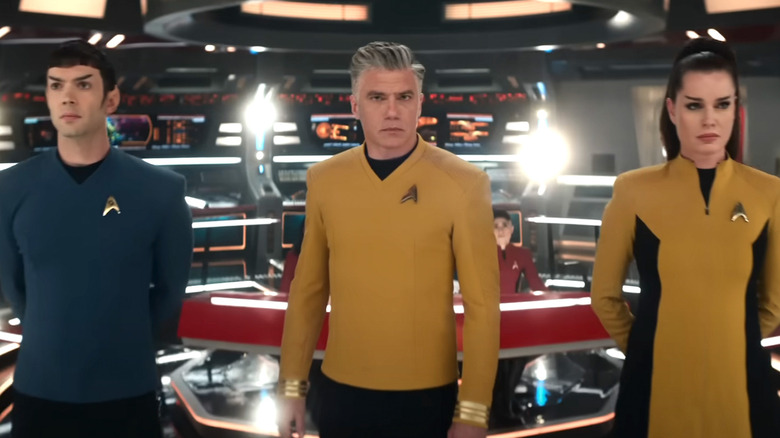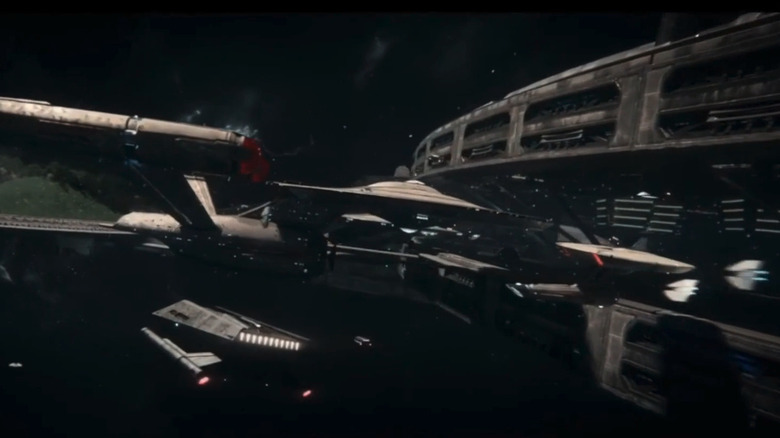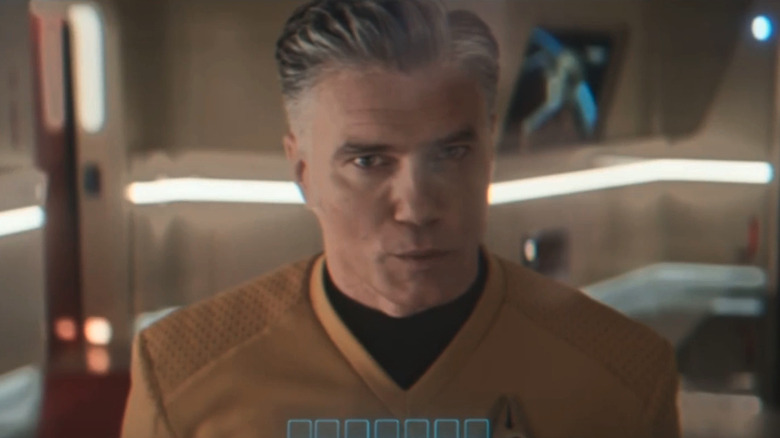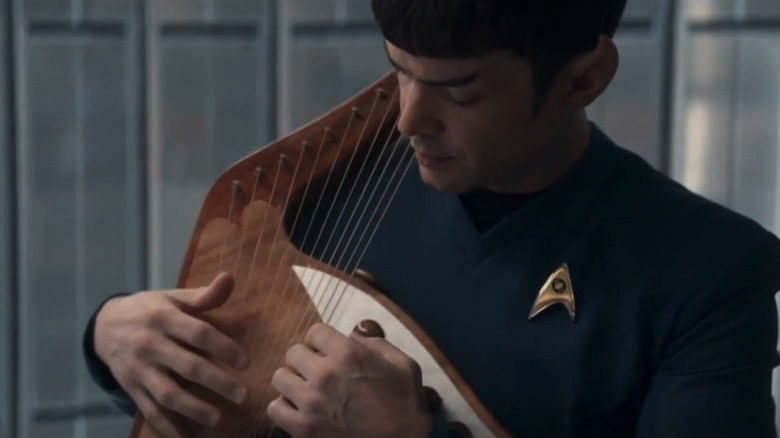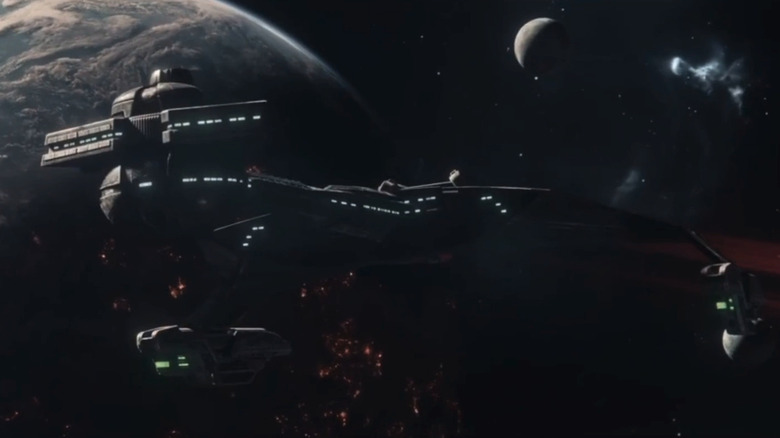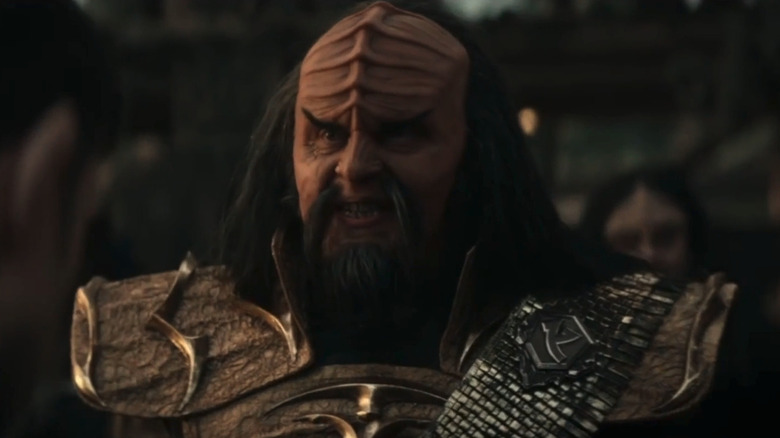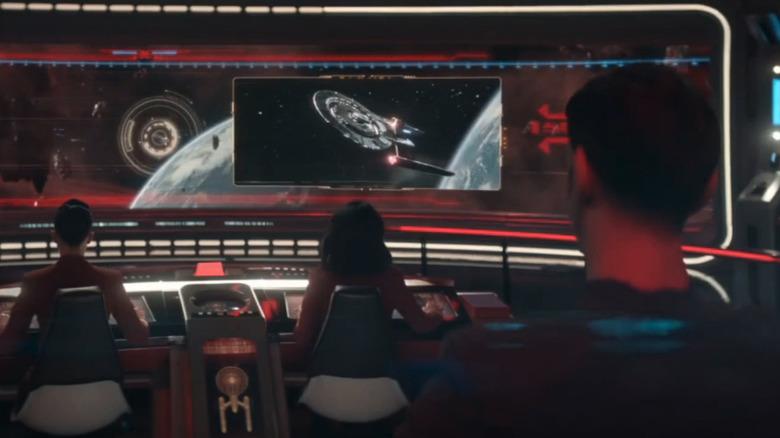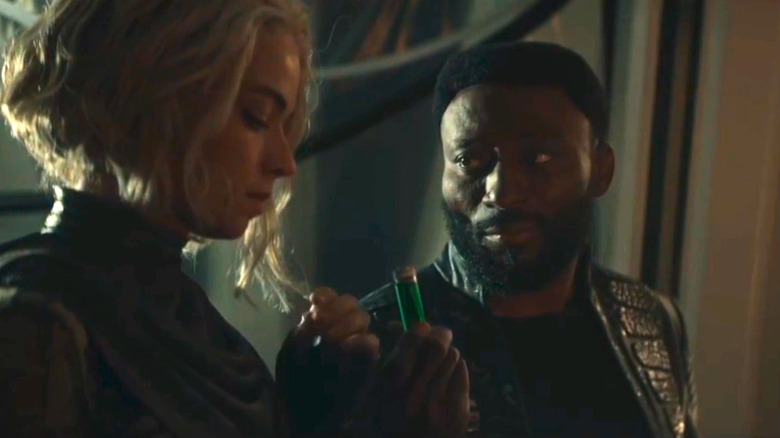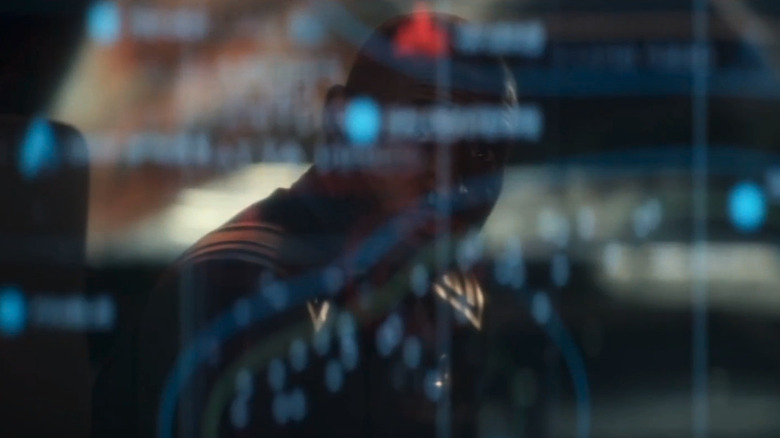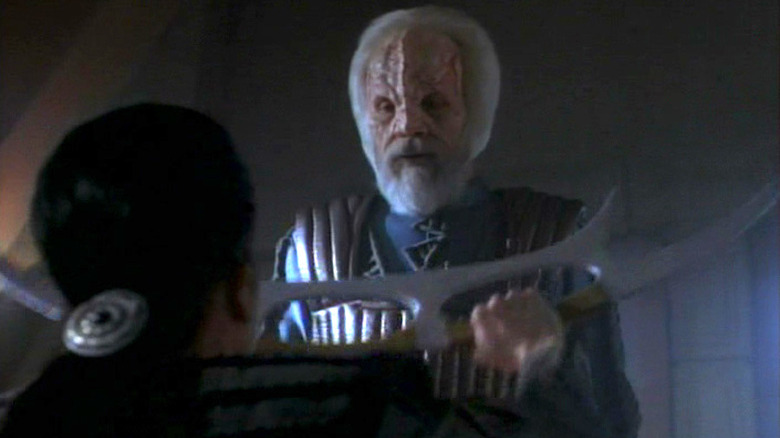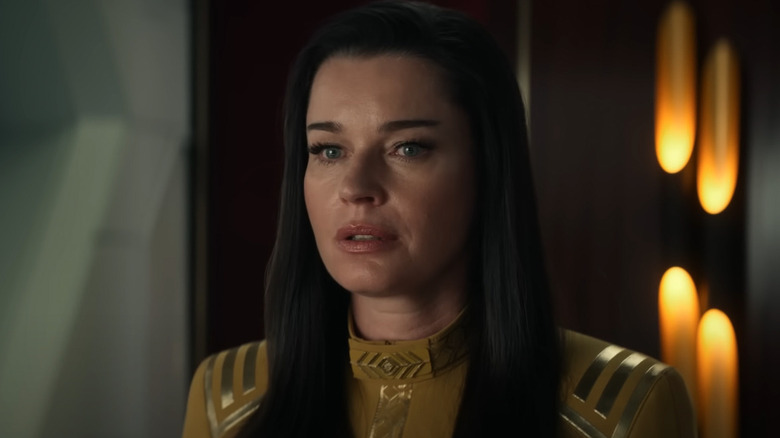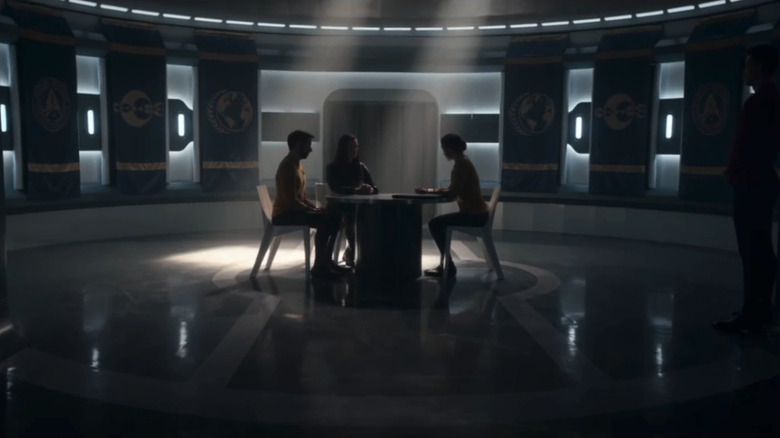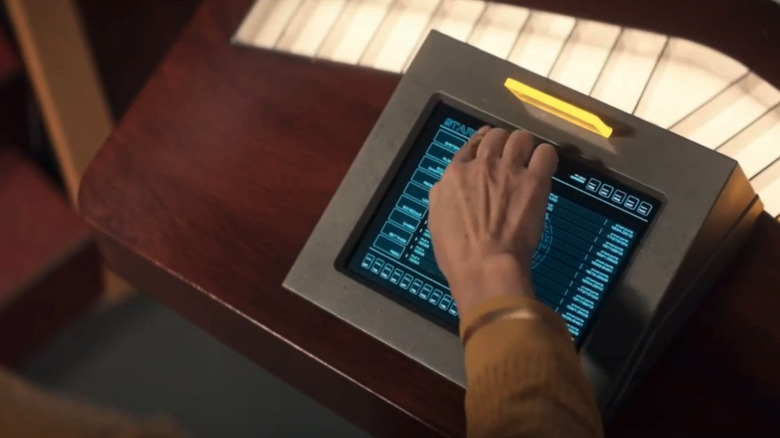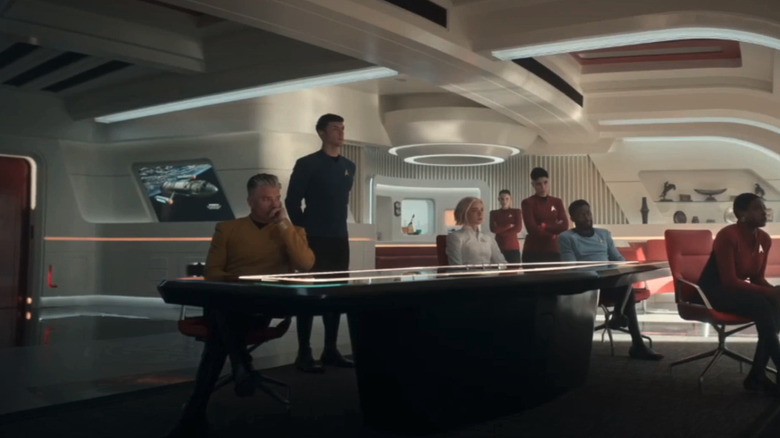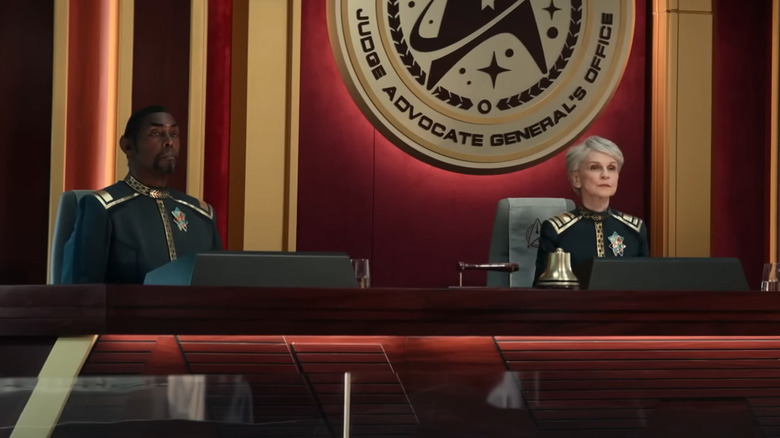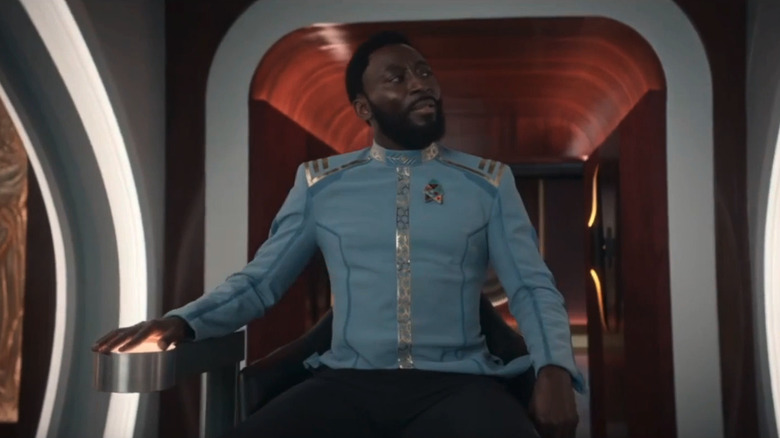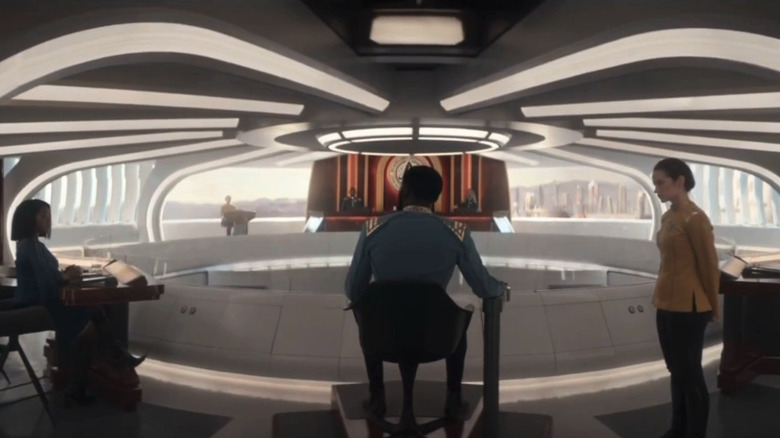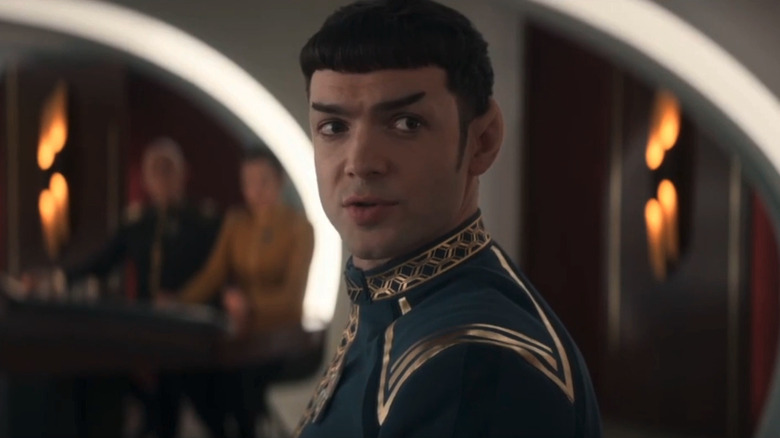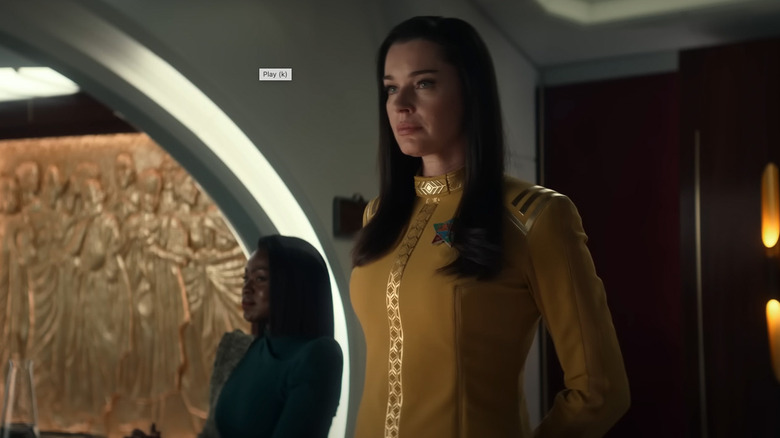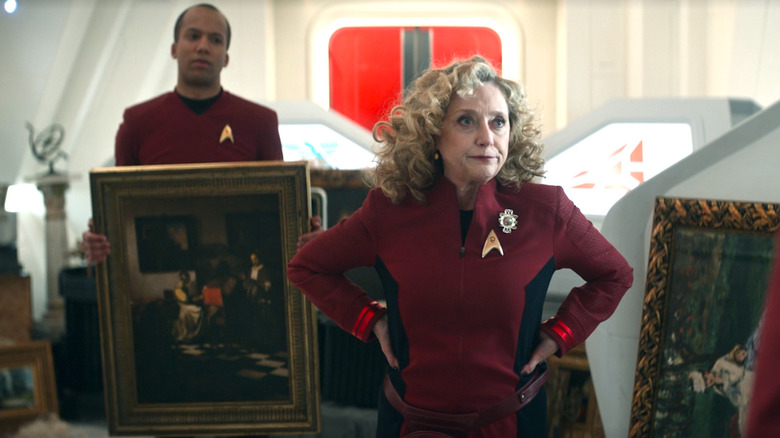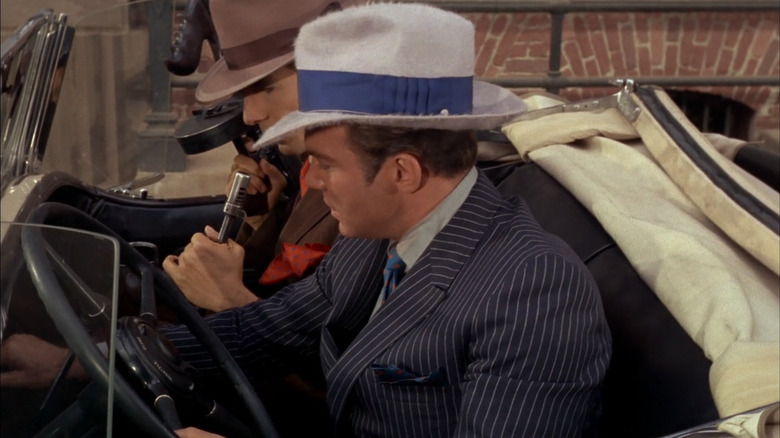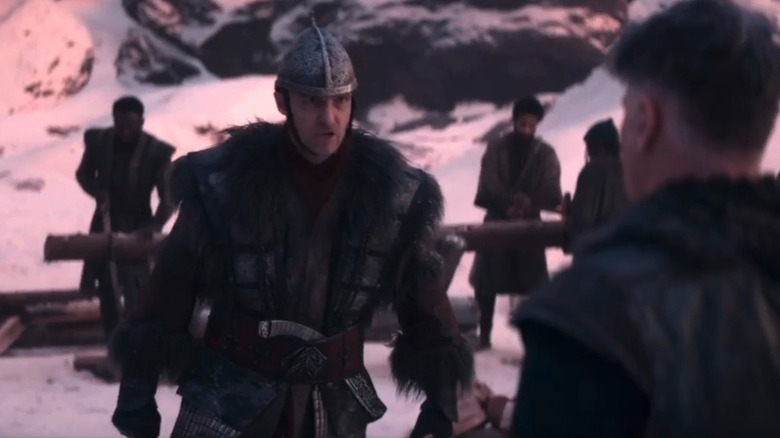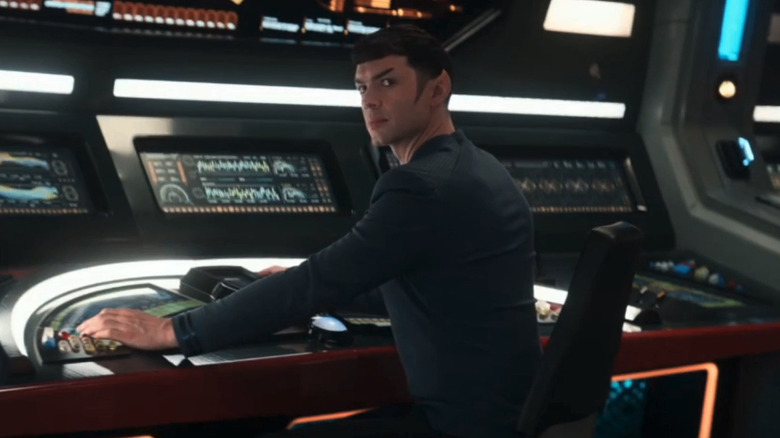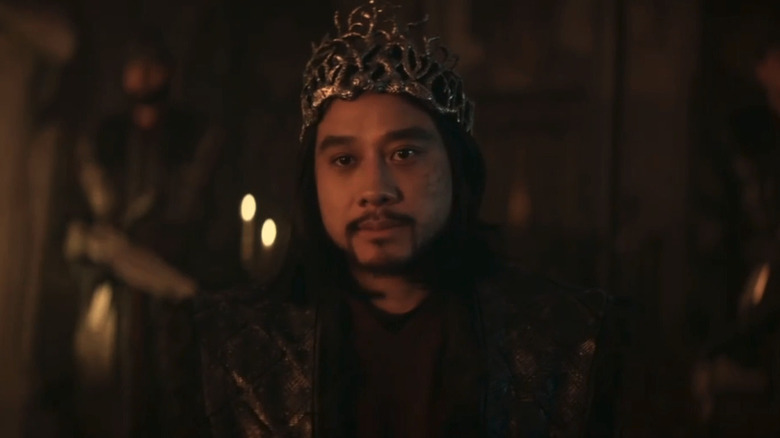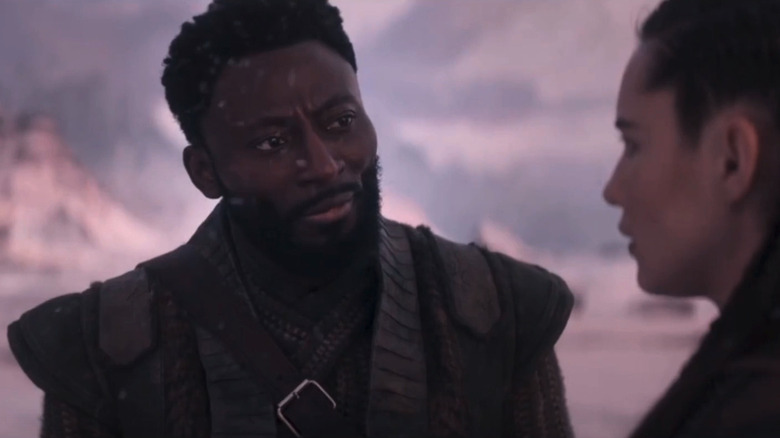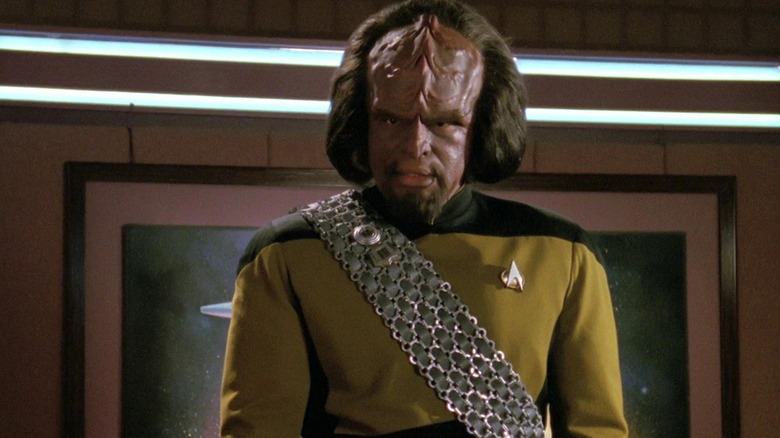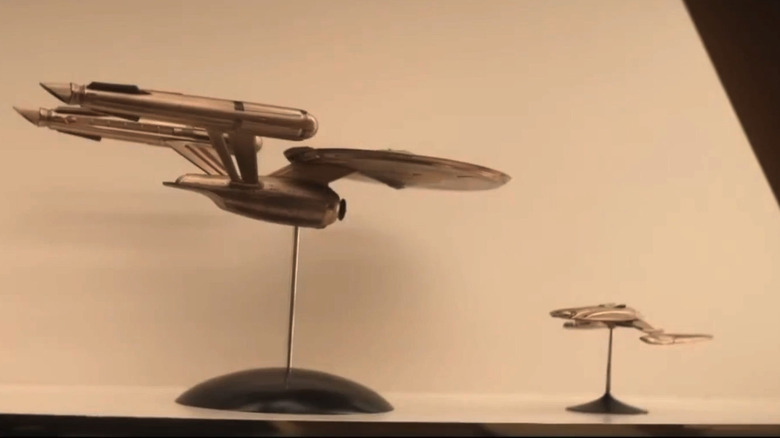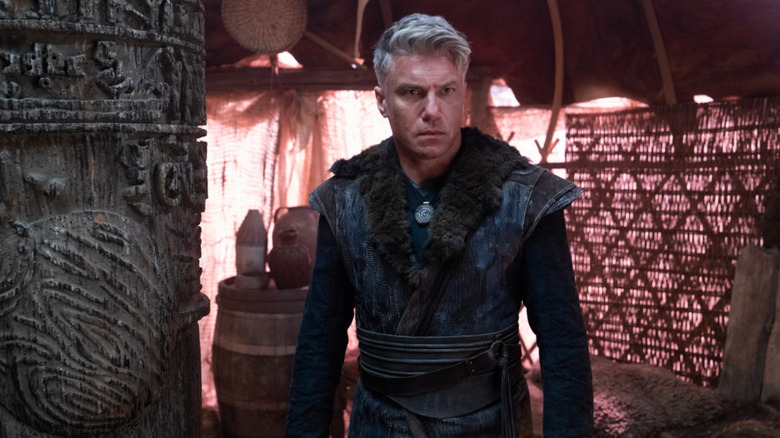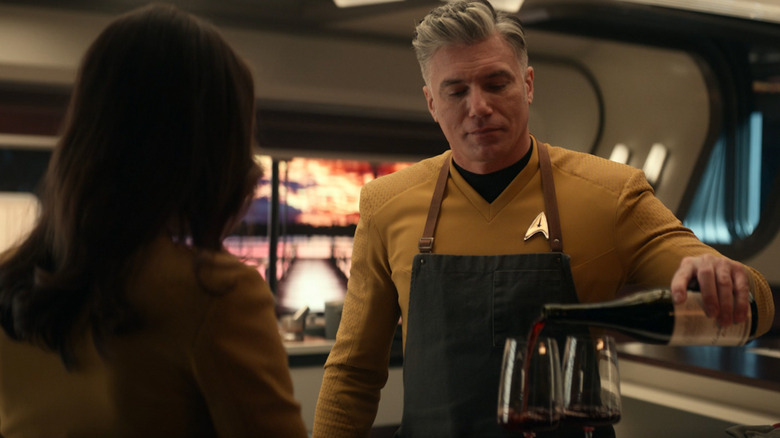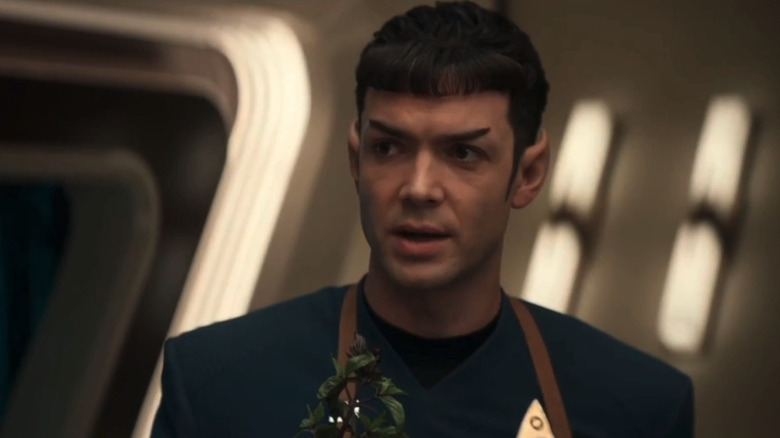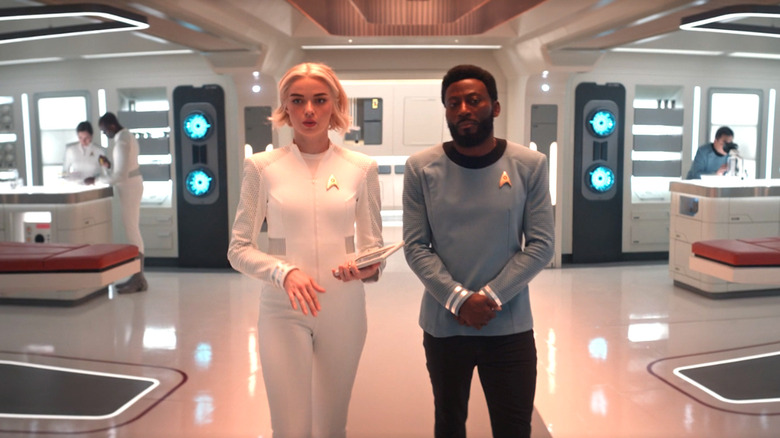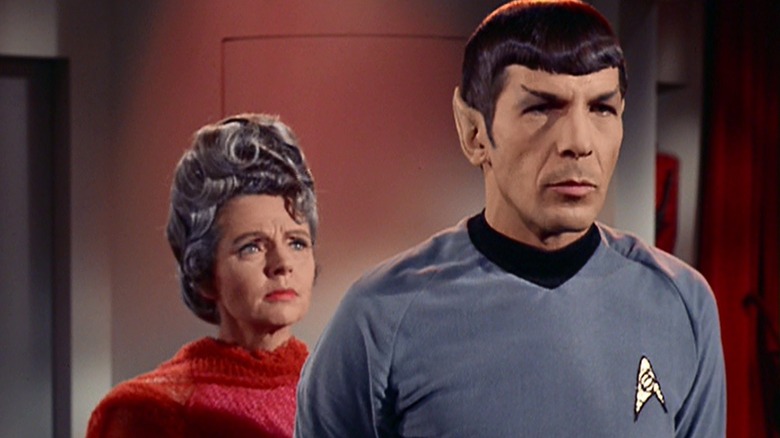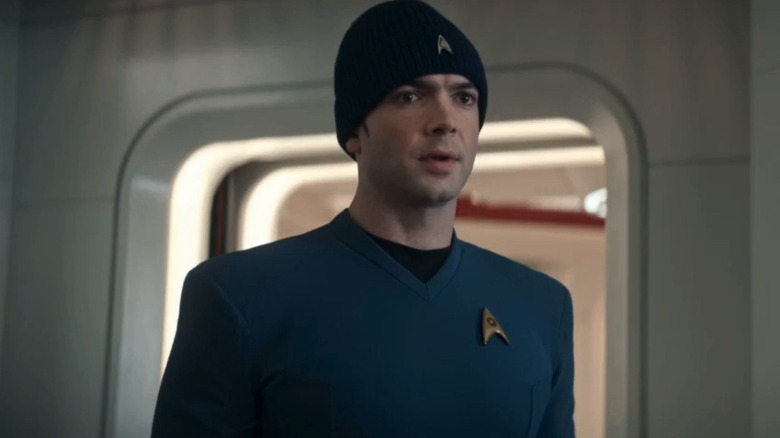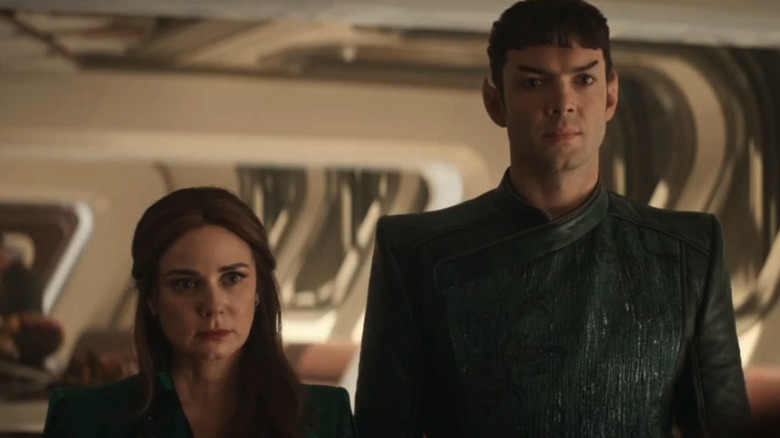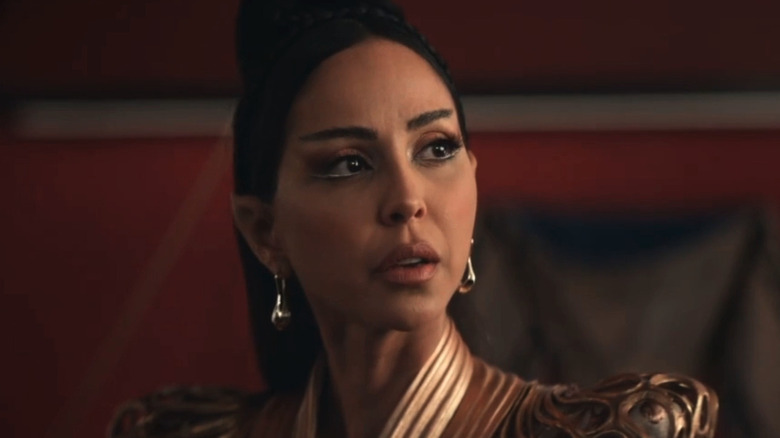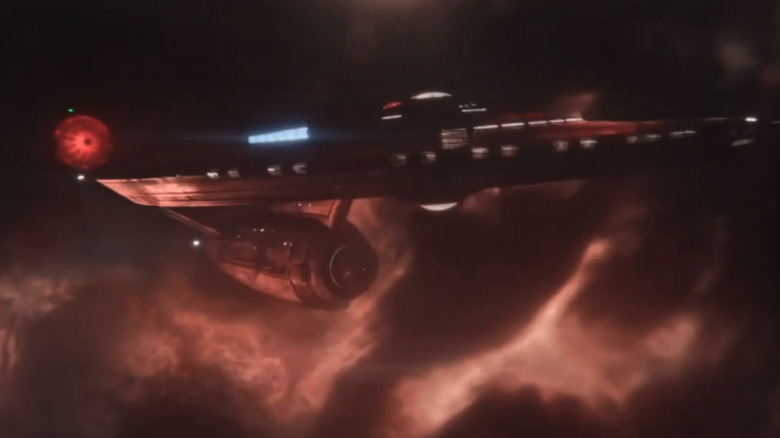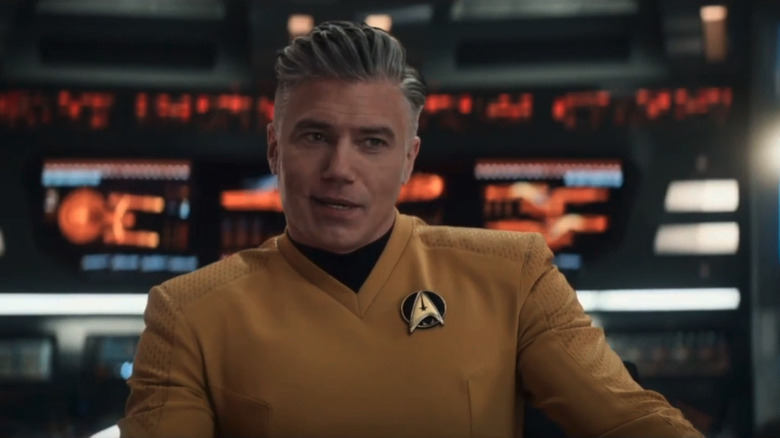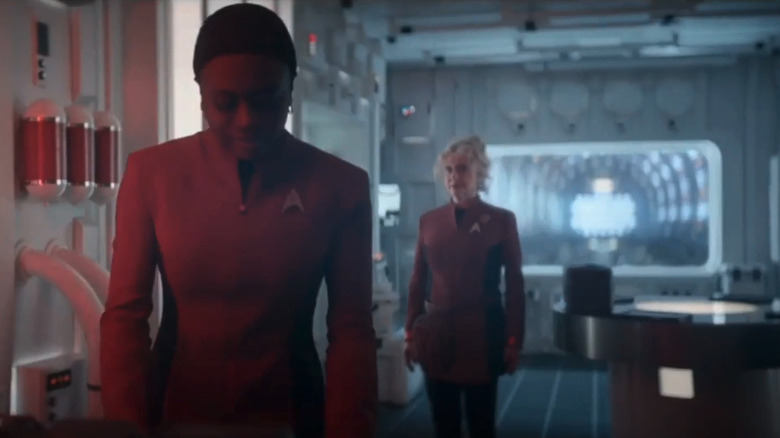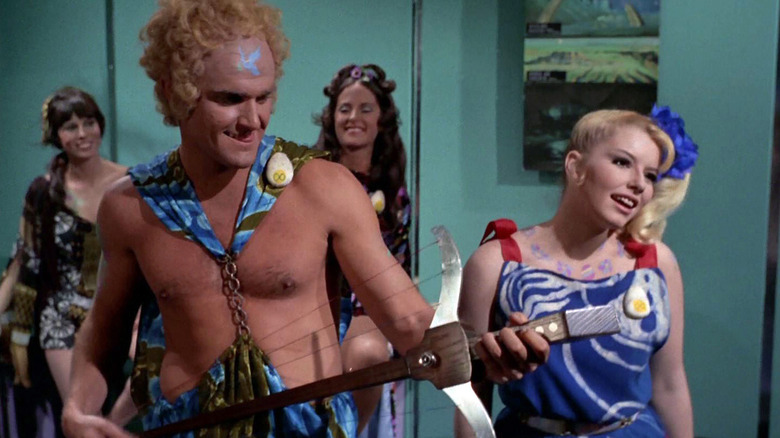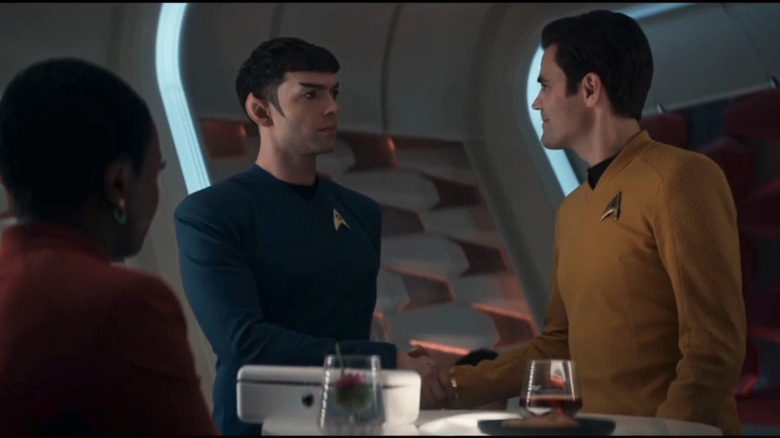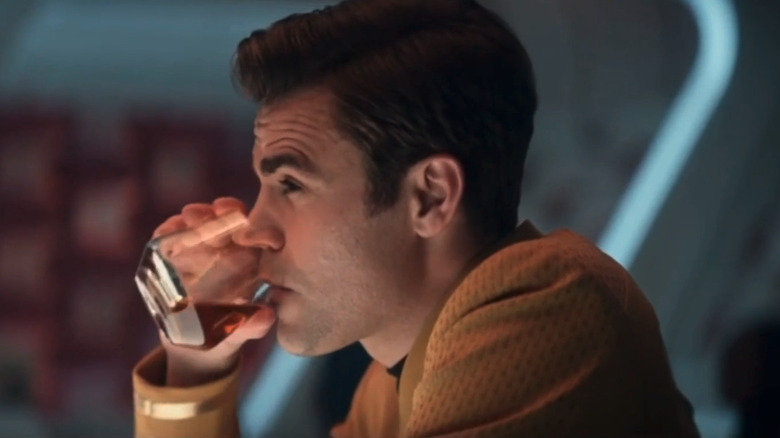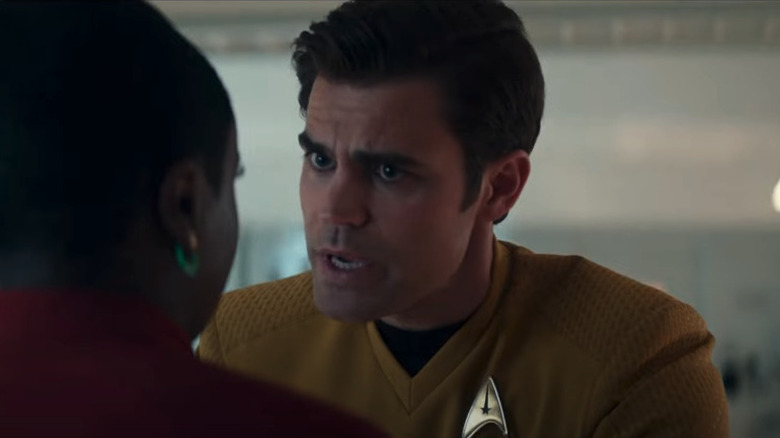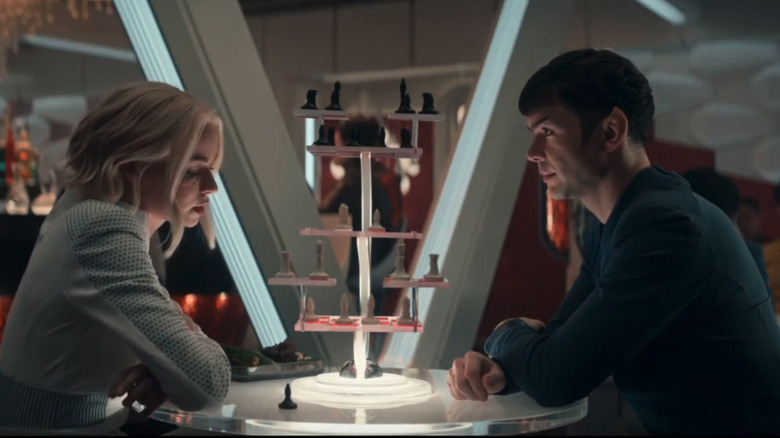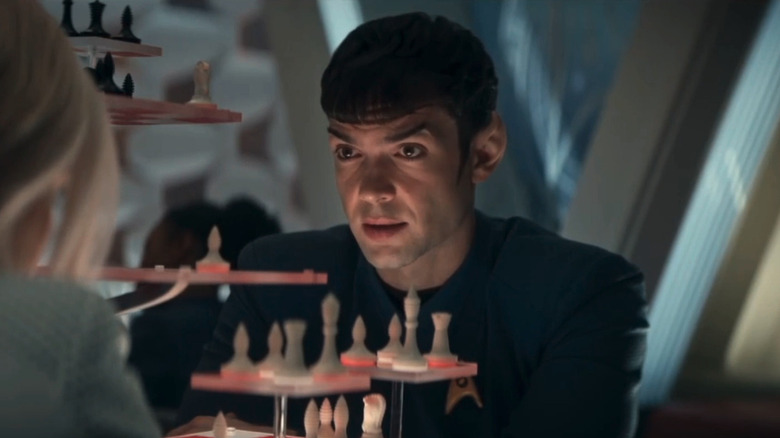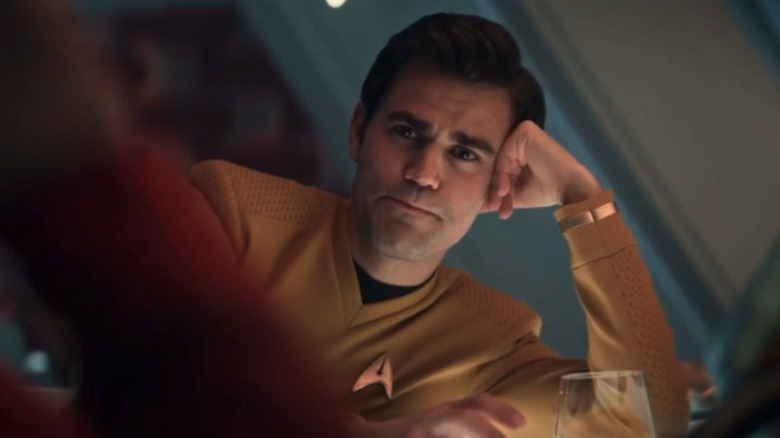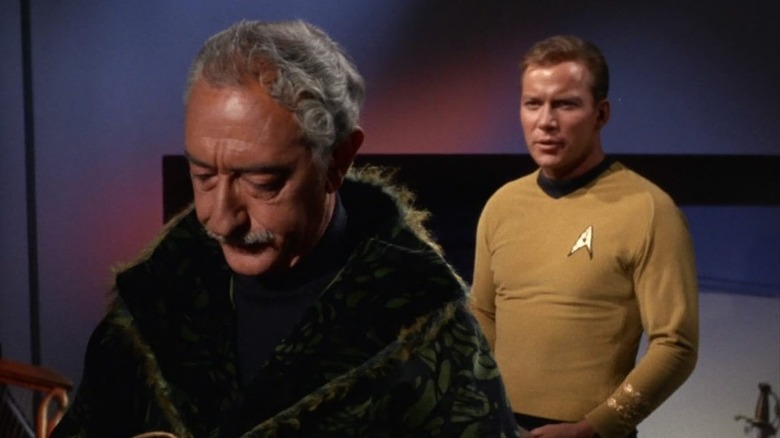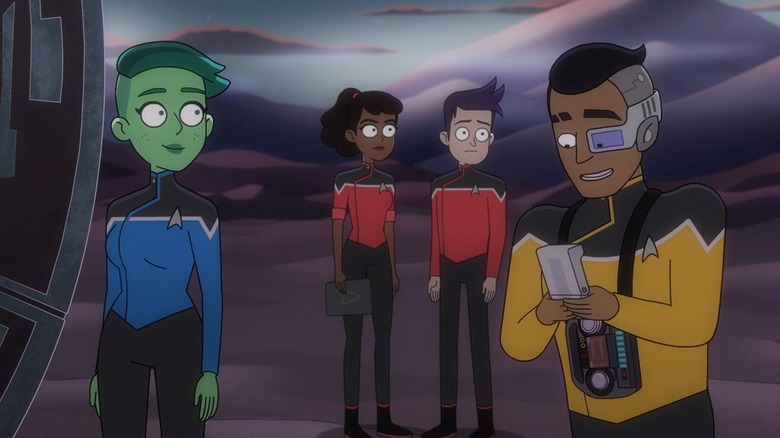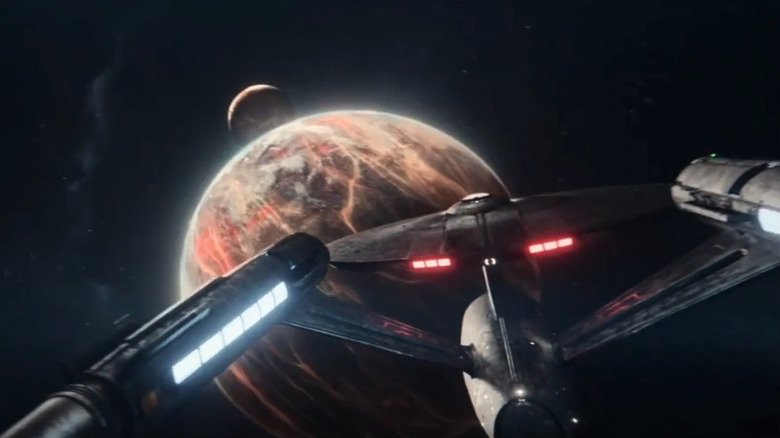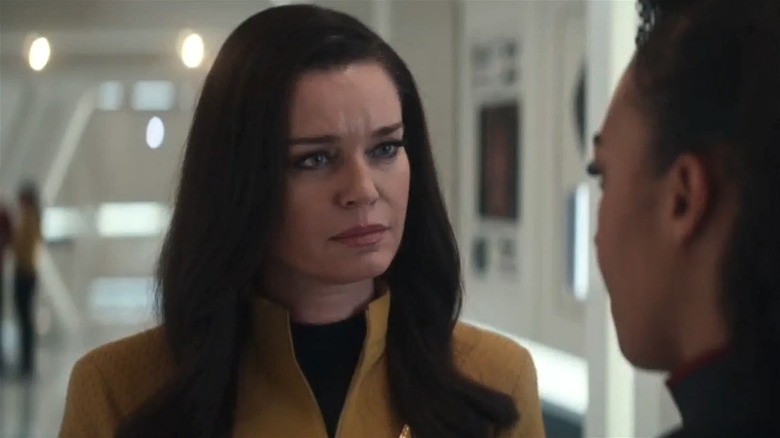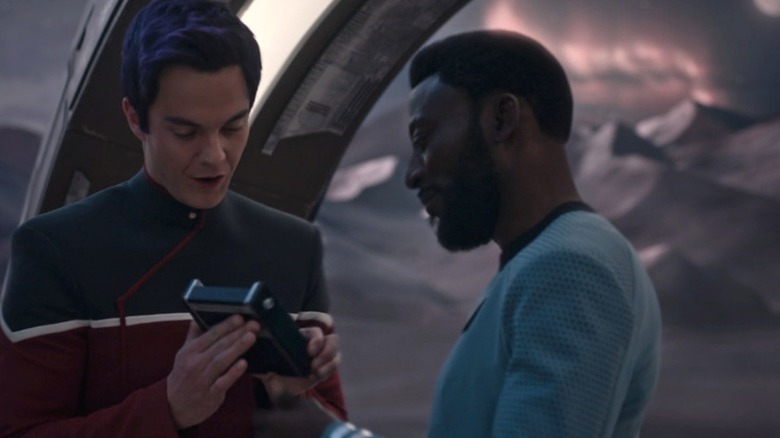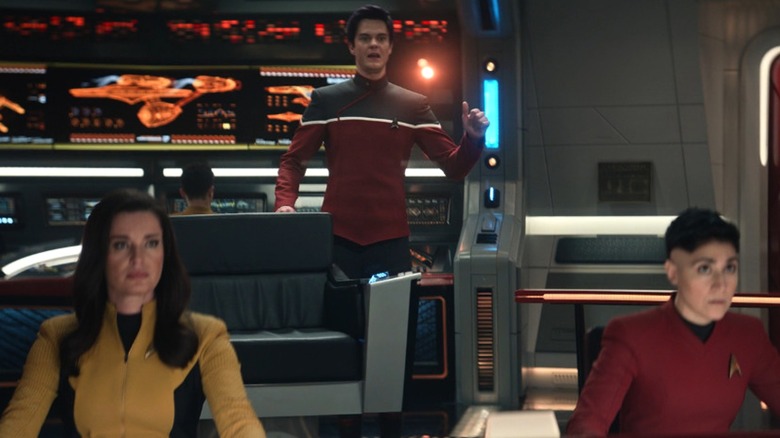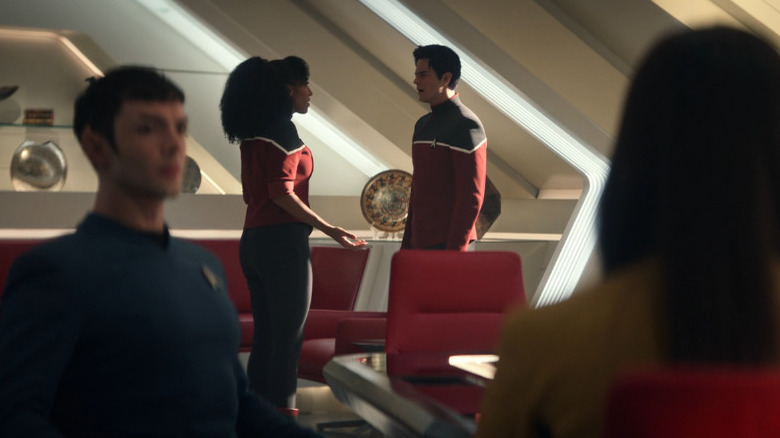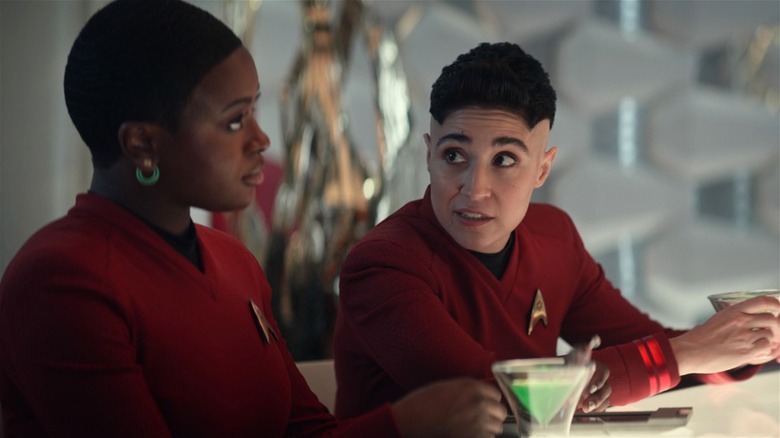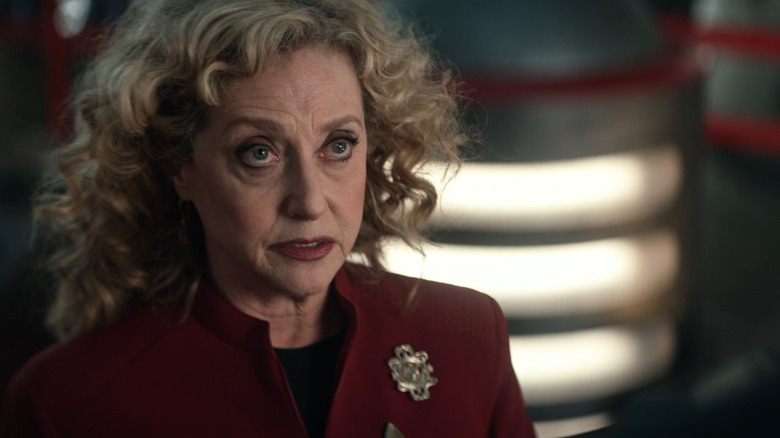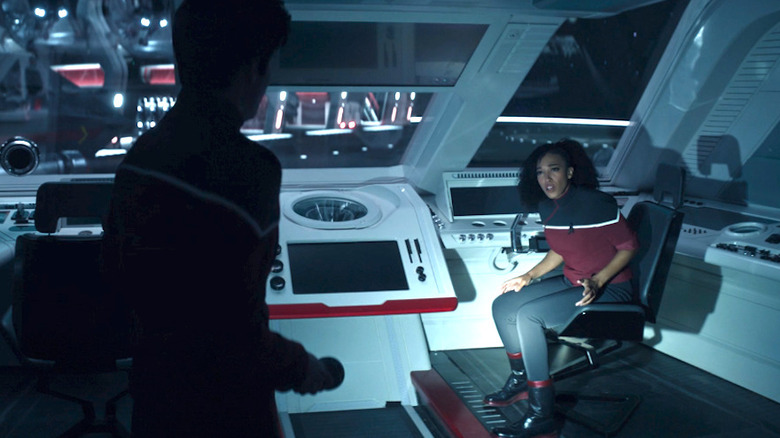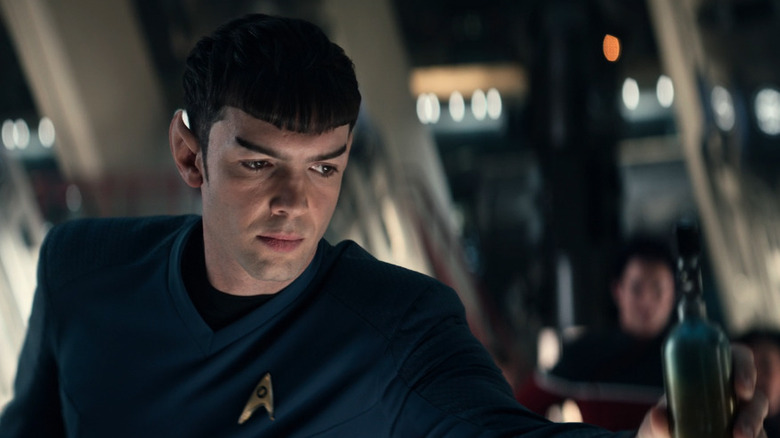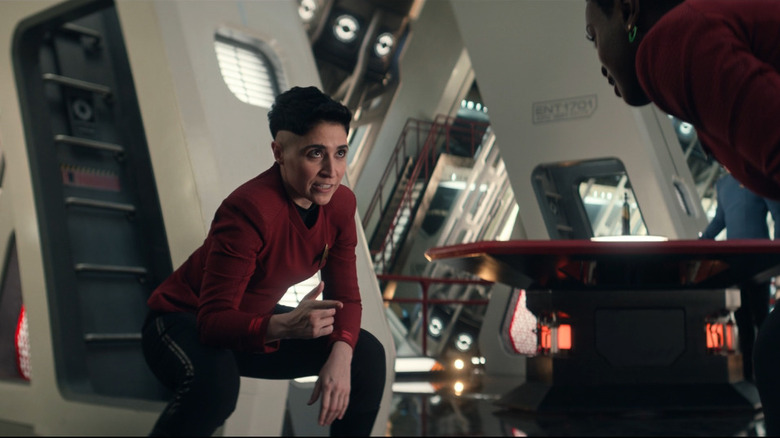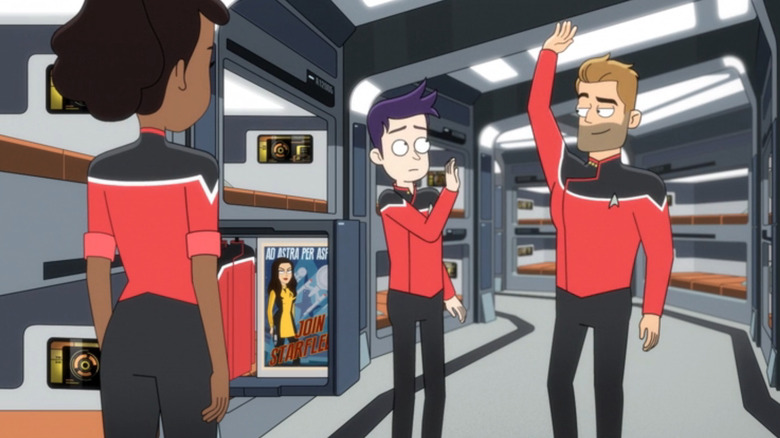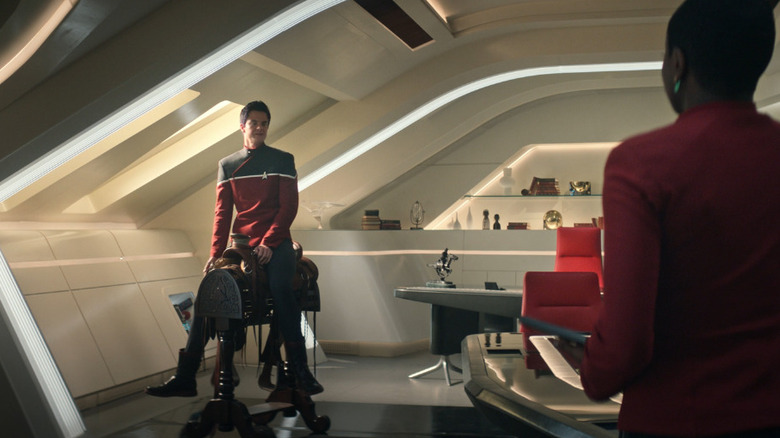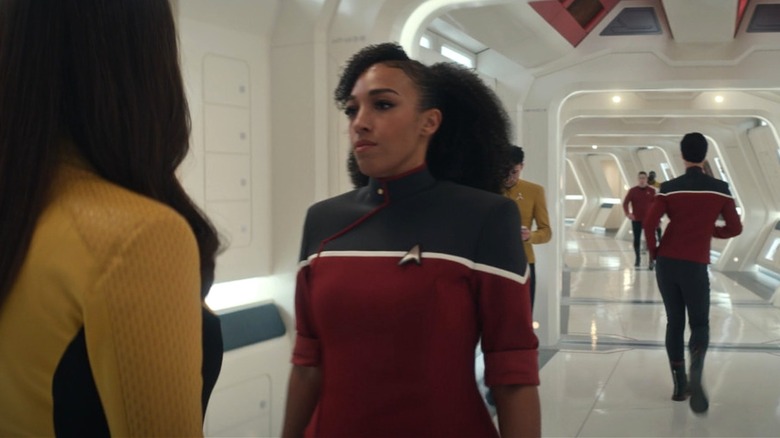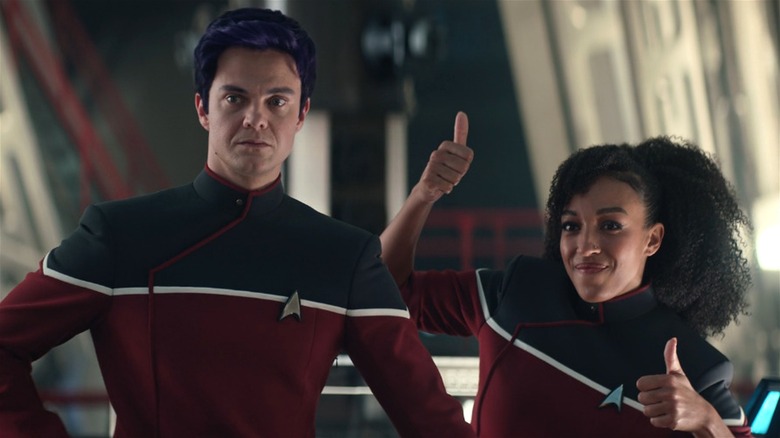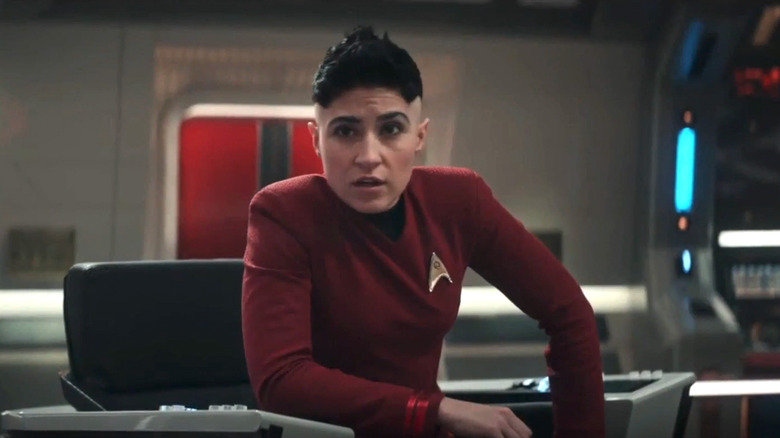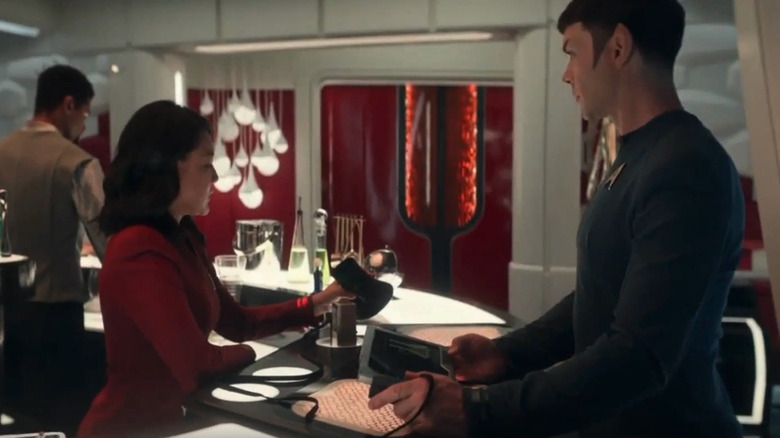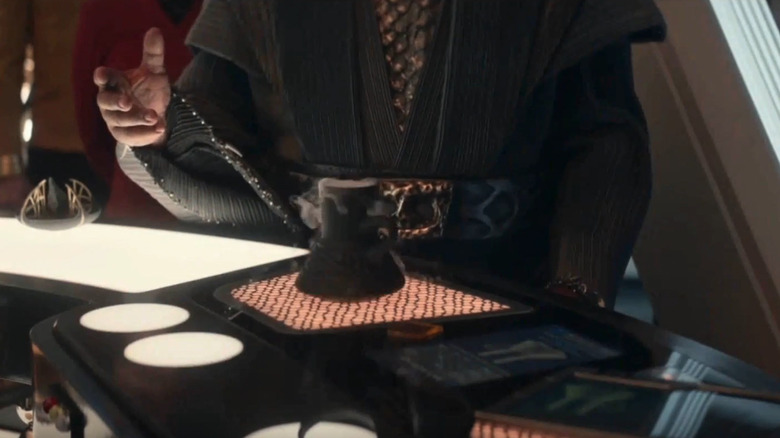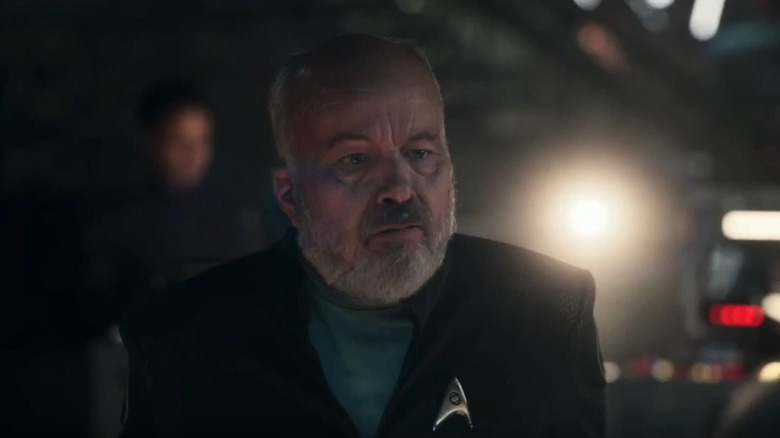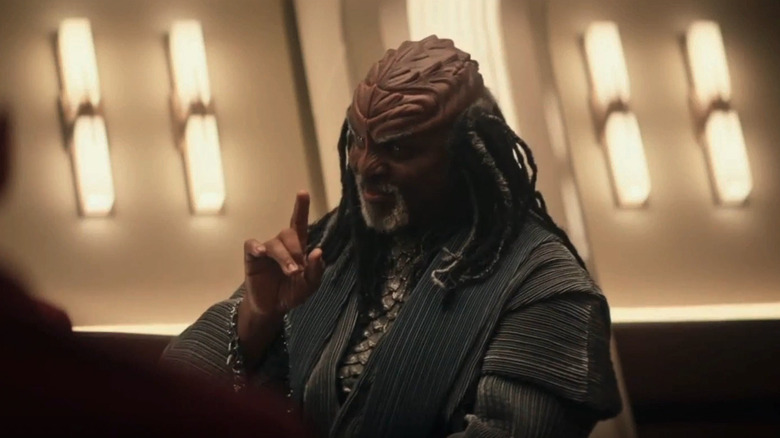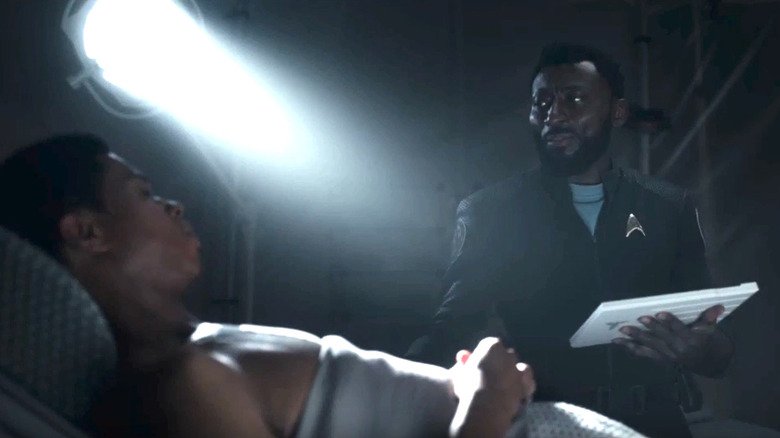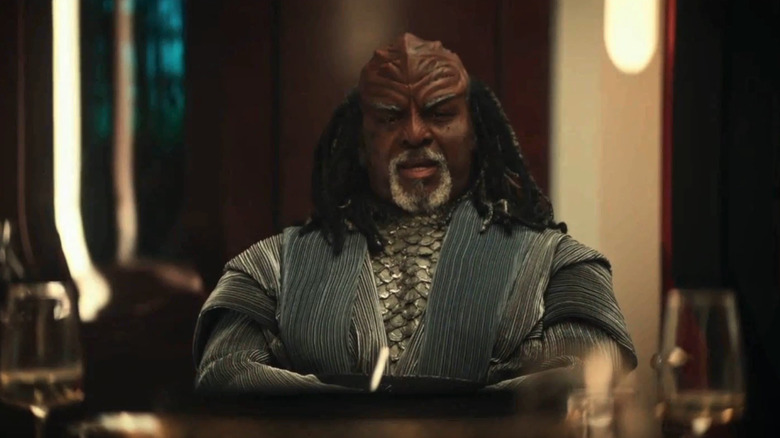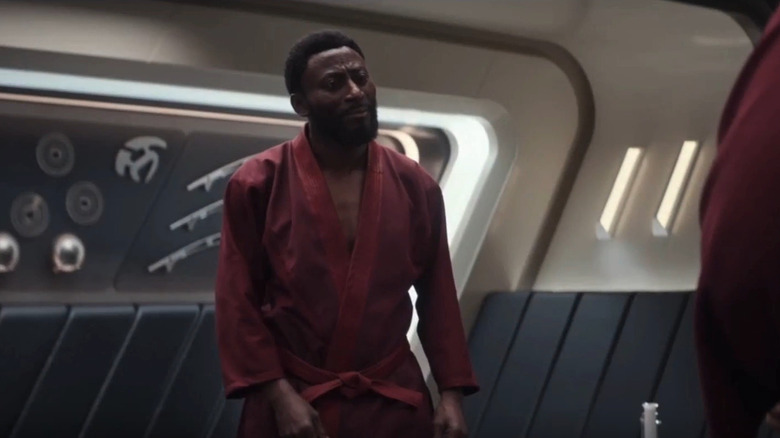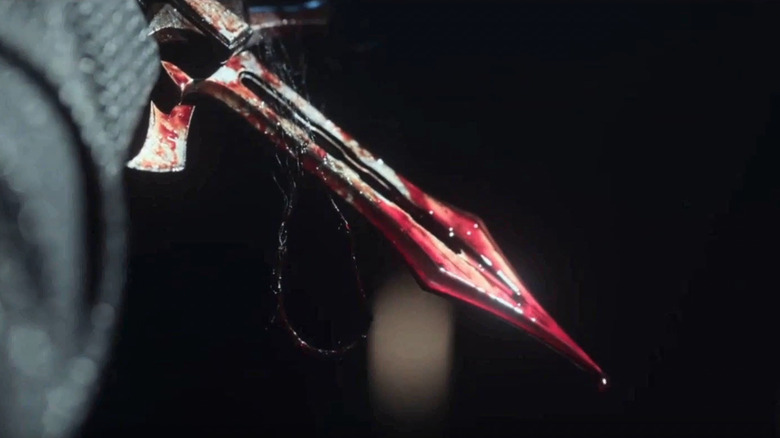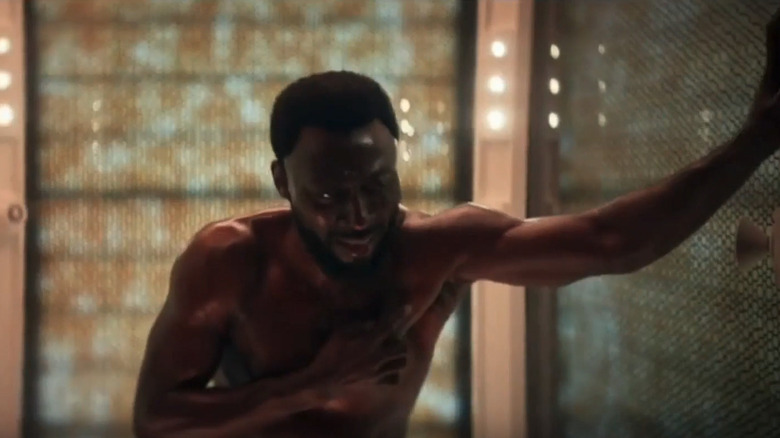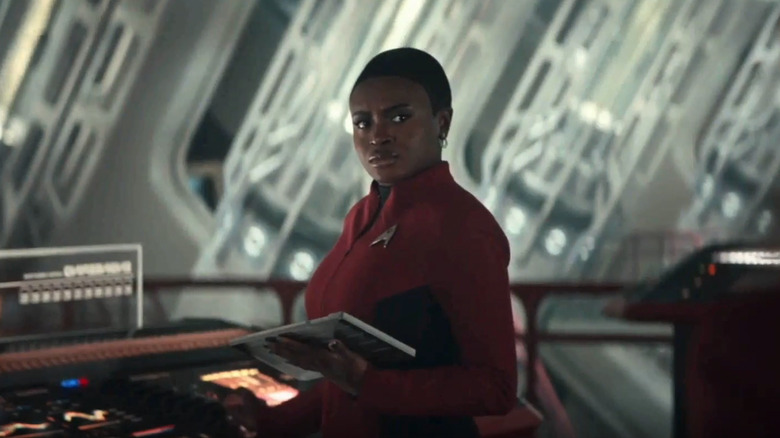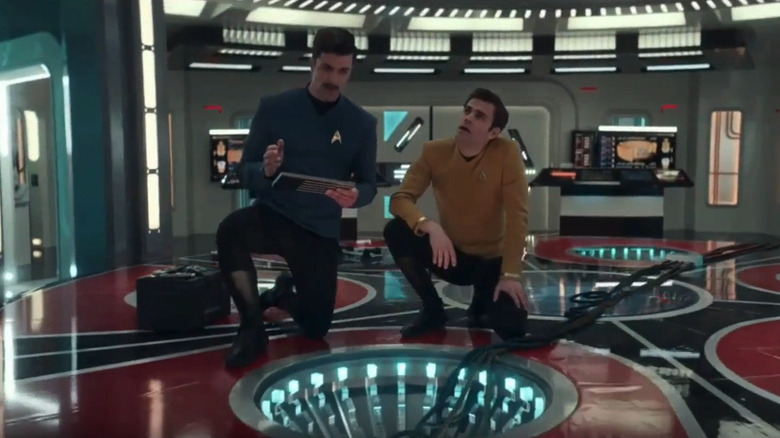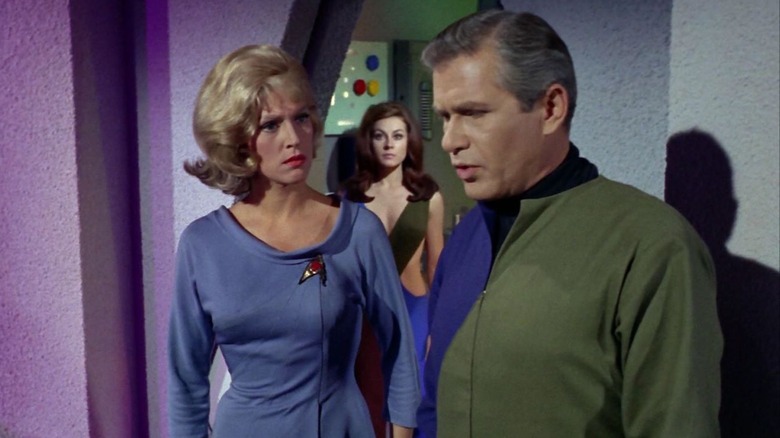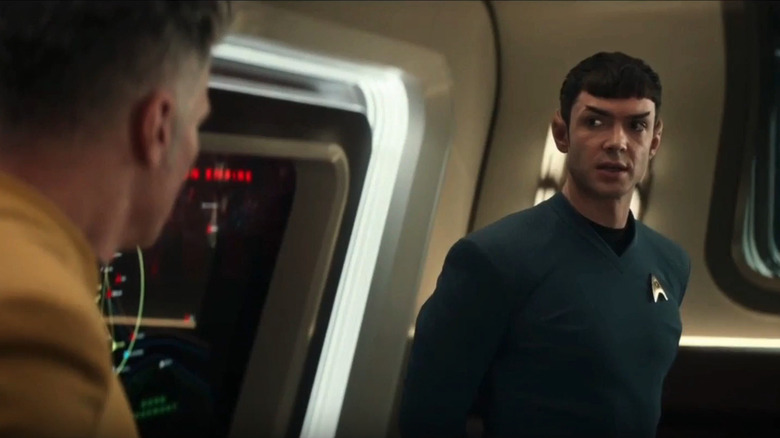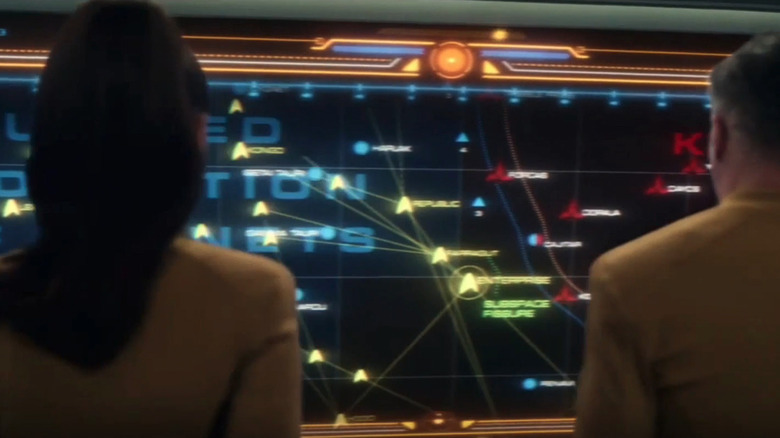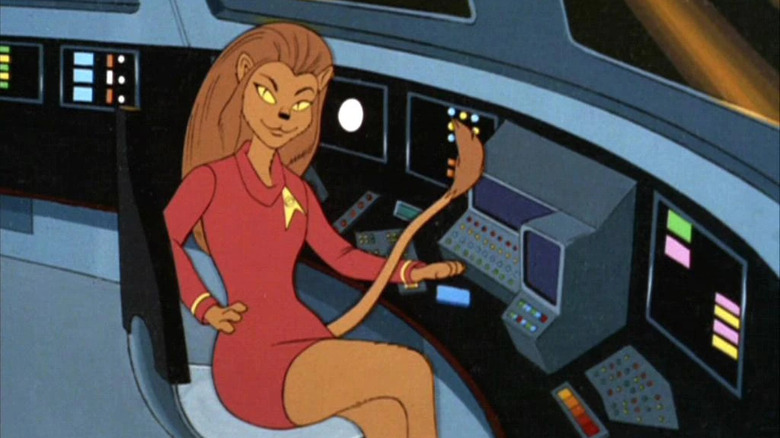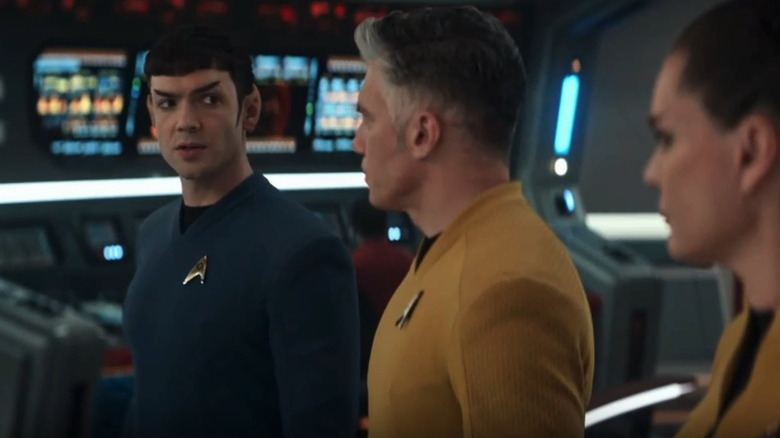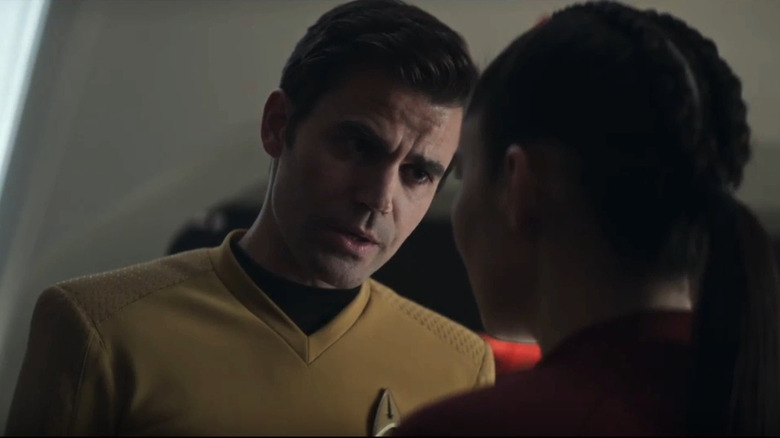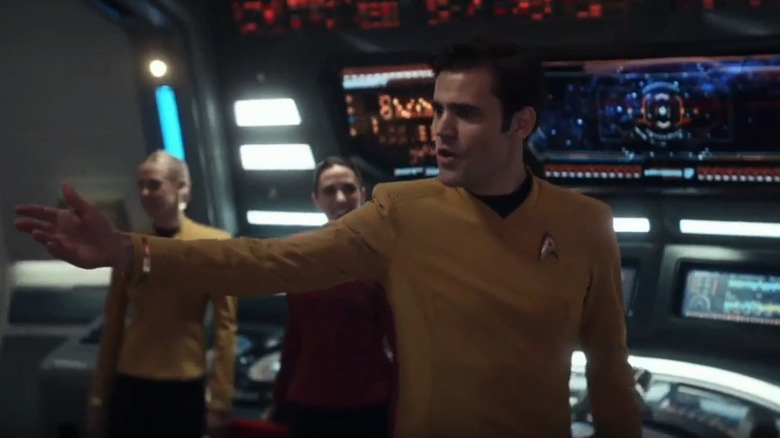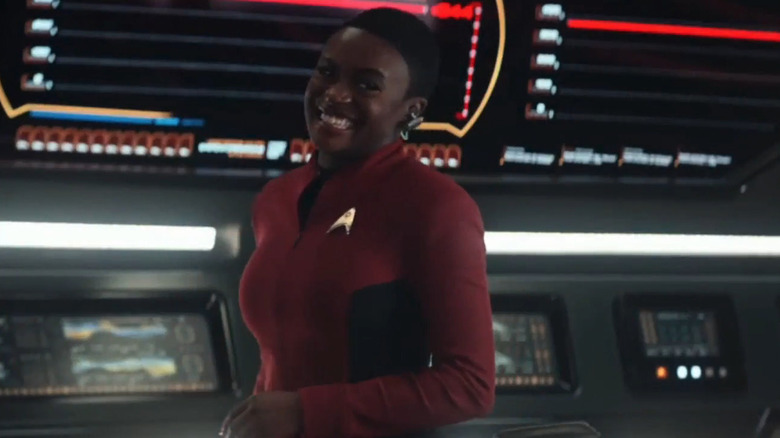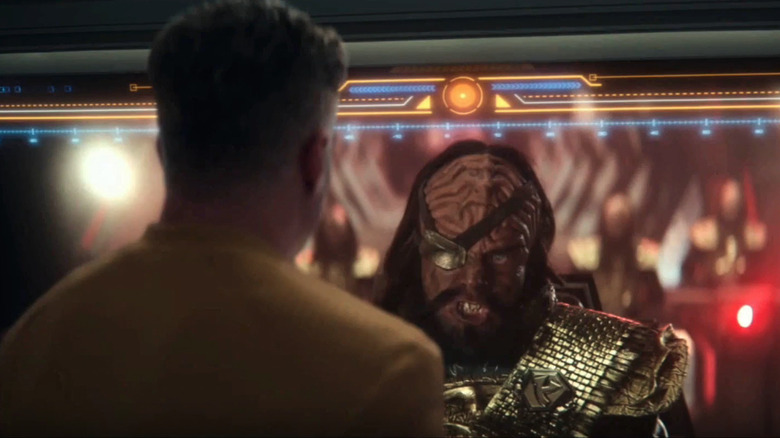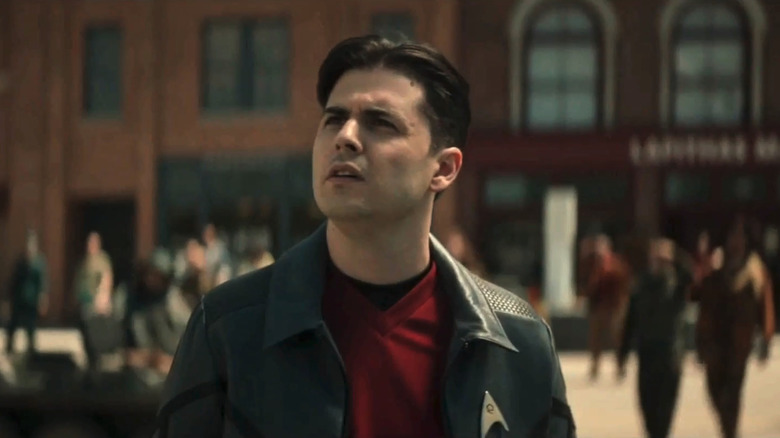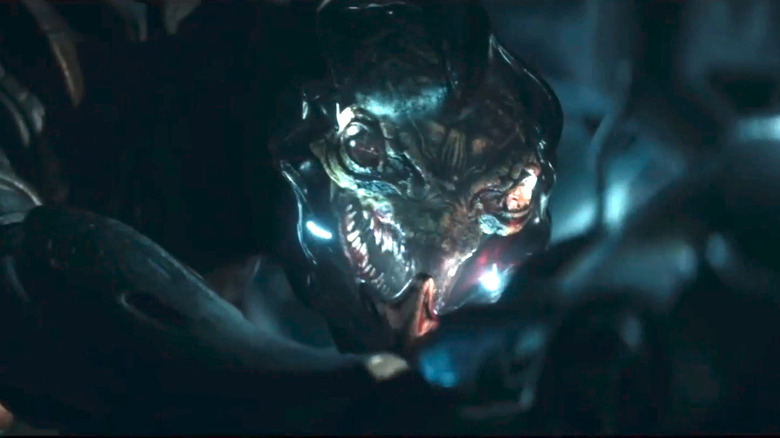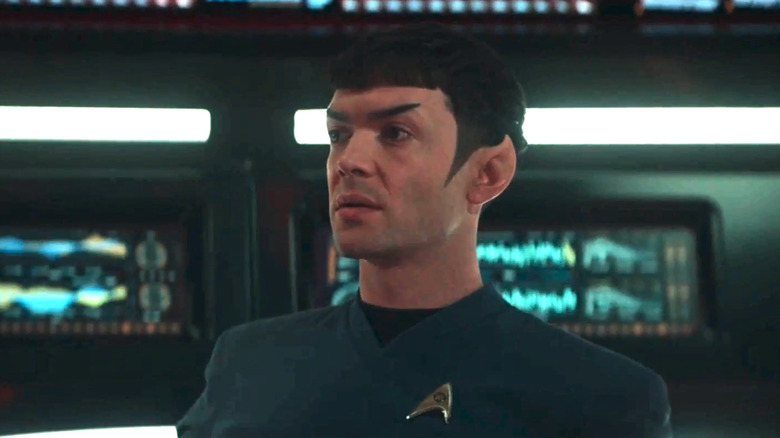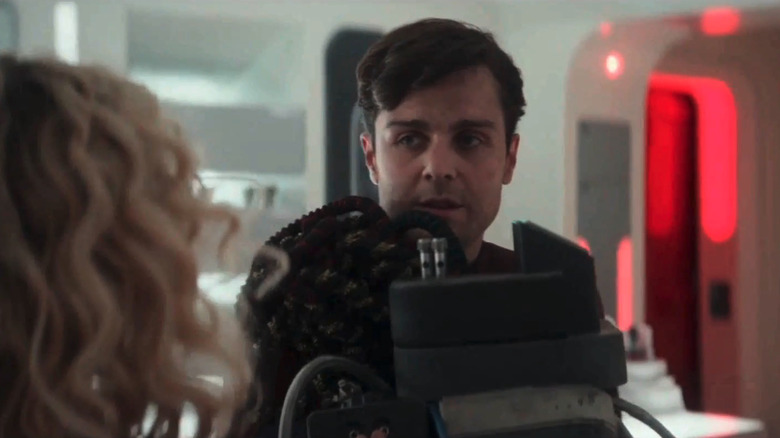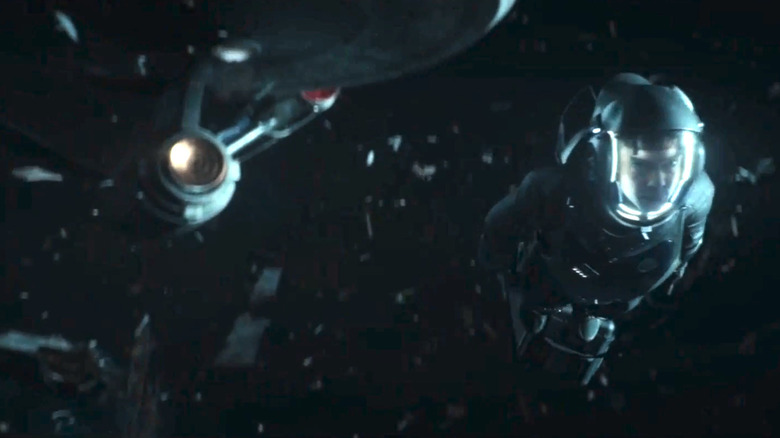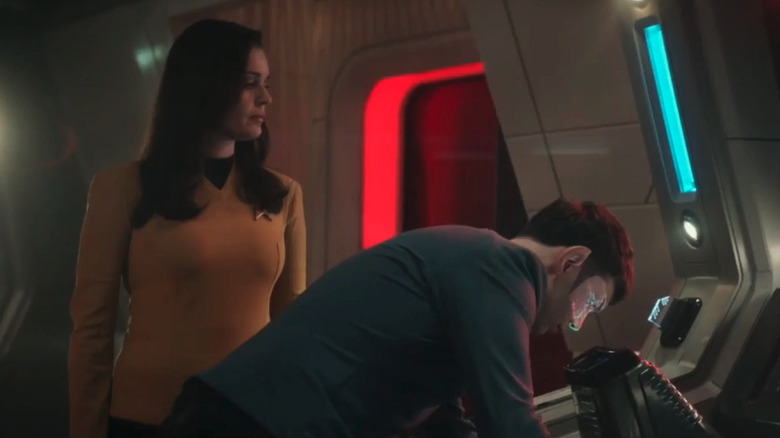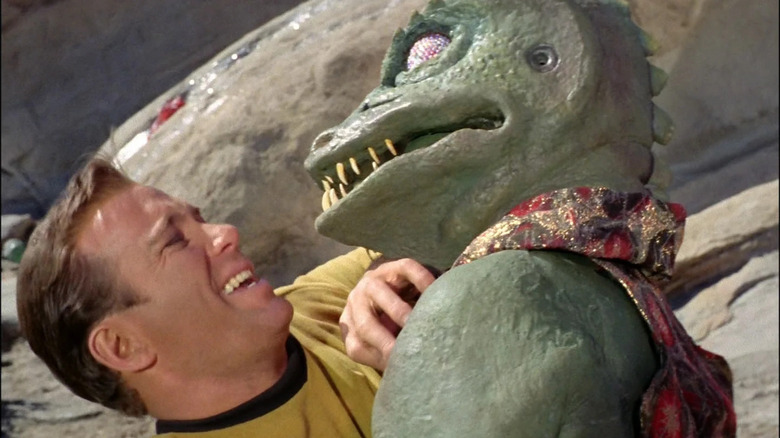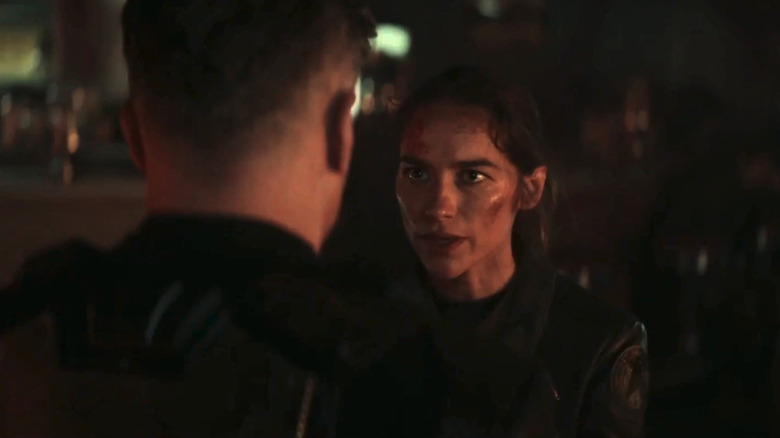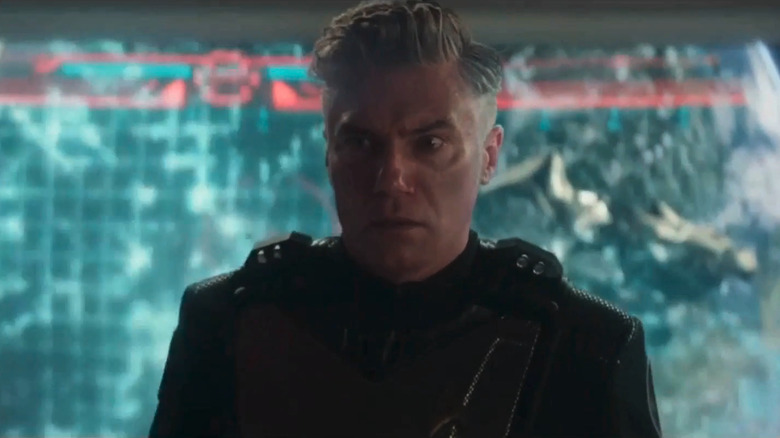Easter Eggs And References You Missed In Star Trek: Strange New Worlds Season 2
Contains spoilers for Season 2 of "Star Trek: Strange New Worlds"
"Star Trek: Strange New Worlds" took the franchise back to the adventures of Captain Pike, Number One, and Mr. Spock, picking up where things left off in "Star Trek: Discovery," but with a more episodic approach, featuring 10 stories at the edges of the final frontier. Set several years before Captain Kirk took command, the series also featured Cadet Uhura, Nurse Chapel, and Dr. M'Benga, who all played key roles in the original "Star Trek" series, as well as plenty of new characters, including hotshot pilot Ortegas, tough-as-nails security chief La'an, and surly engineer Hemmer.
Over the course of the first season, we saw Pike confront his own fate and Mr. Spock be torn between duty and family, while Number One had to expose her deepest secret and risk her entire career to save the ship. We even got a glimpse of a dark possible future and met a different version of Captain Kirk. But Season 1 was also jam-packed with easter eggs and references to "Star Trek" history, including little-known alien races and subtle nods to old starships, planets, and characters we never thought we'd see again.
Now "Strange New Worlds" has returned for Season 2, picking up where the first left off, following up on several unresolved plot lines, and featuring plenty of homages to the franchise's past. We're checking out each episode, and putting together a list of our favorite easter eggs and references that you might have missed.
A new model of Starfleet repair drones
When the Season 2 premiere, "The Broken Circle," begins, we see the USS Enterprise docked at Starbase 1, undergoing a series of maintenance overhauls and system upgrades overseen by Commander Pelia (played by screen legend and new recurring cast member Carol Kane). Alongside what appears to be the USS Archer — named for Captain Jonathan Archer of "Star Trek: Enterprise" and first seen in the "Strange New Worlds" Season 1 premiere — the Enterprise is attended to by a series of repair drones.
Though we have never seen this model of repair drone before, they're not a new concept. They first appeared in episodes of "Star Trek: Short Treks," and later "Star Trek: Discovery," but those were more anthropomorphic droids than the sleek, wedge-shaped ships we see here. While we never got a great look at them, they also appear in "Star Trek: Picard," attending to repairs after the USS Titan's battle with Vadic's starship the Shrike. The new design seen in "The Broken Circle" suggests that there are many different models of repair drones, perhaps each with its own unique function, and that they have continued to evolve over time.
Jonathan Archer's original Enterprise
In Season 1 of "Strange New Worlds," Captain Pike's ready room — which also doubles as the senior staff's conference lounge — was seen decorated with all manor of mementos. It was also adorned with two pieces of wall art depicting ships from Starfleet's past, which were white-on-white engravings of the starship Essex (from the TNG episode "Power Play") and the USS Phoenix (from "Star Trek: First Contact"). But the ready room gets an overhaul for Season 2 that replaces at least one of the two starship images with a new piece of artwork depicting a different ship entirely.
"The Broken Circle" gives us a glimpse of the new artwork that replaces the Essex behind Pike during his communication with Number One at the beginning of the episode. And while it's a bit fuzzy, pre-release trailers that showed an extended scene from a future episode of the season confirm that it is in fact a painting of Captain Archer's NX-01 Enterprise, the title starship in 2001's "Star Trek: Enterprise." As the first Starfleet ship to bear that iconic name, it was the founding ship of the line with a much greater importance to Pike and the 1701 Enterprise than the Essex.
As fans may know, this is now the second glimpse at Archer's Enterprise this year, as "Star Trek: Picard" showed off the NX-01 at the Fleet Museum in an easter egg from Season 3.
Spock's Vulcan lute
The "Strange New Worlds" Season 1 episode "All Those Who Wander" sees Mr. Spock unleash a wave of emotion to defeat the Gorn. As a result, he's left with lingering psychological issues, and in "The Broken Circle," Dr. M'Benga notes that this could be something that Mr. Spock will have to learn to live with. Rather than prescribe powerful drugs to help with his more freely flowing emotions, M'Benga provides Spock with a "more human therapy," recommending he channel his stress into music. To that end, he gives Spock an instrument that longtime Trekkies will surely recognize.
Known as a Vulcan lute, it's a 12-stringed instrument from Spock's native planet. In the original "Star Trek" series, Spock was seen playing it on multiple occasions as a way of relaxing, most notably in classic installments like "Charlie X" and "Amok Time." He even played the lute in "The Paradise Syndrome" after realizing that the mystery of the Amerind obelisk somehow involved a musical scale.
Spock isn't the only one to play the lute, though. In the 1966 episode "The Conscience of the King," Lt. Uhura played the song "Beyond Antares" for the crew. In "The Broken Circle," we see Spock's history with the instrument may not have been a lifelong hobby as fans may have presumed, but seems to have begun as a therapeutic technique to control his emotions.
The Klingon D7 battlecruiser
When it comes to iconic starships, "Star Trek" is full of them, and it's not just the USS Enterprise, the original model of which now sits in the Smithsonian Air & Space Museum. Debuting in the original "Star Trek" series episode "Elaan of Troyius," the Klingon D7 class battlecruiser is another legendary ship in the franchise, appearing multiple times over the years. It was given a big screen facelift to become the K'Tinga Class battlecruiser for three of the "Star Trek" movies, which became the standard Klingon cruiser for the next few decades.
The D7 class battlecruiser made its return in a 2019 episode of "Star Trek: Discovery," which also gave it a slick new redesign with plenty of added detail for modern audiences. "The Broken Circle" is the first time in quite a few years that we've gotten a look at the original D7, making its triumphant debut in "Strange New Worlds." The episode is also chronologically the earliest instance we've seen of the USS Enterprise in a one-on-one face-off with the iconic Klingon starship, this time with acting captain Spock at the helm.
The old Klingon look is new again
The Klingon D7 battlecruiser isn't the only thing to make a big return in the "Strange New Worlds" Season 2 premiere: The Klingons themselves play a major role, with a new look that's full of hidden meaning. The redesigned aesthetic of the Klingons on "Star Trek: Discovery" in 2017 was one of the most controversial things about the new series, which overhauled the iconic alien race by removing their famous long locks, giving them bulbous heads, and reshaping their head ridges so that they were nearly unrecognizable to many fans.
This polarizing look was somewhat corrected for the second season of "Discovery," but "The Broken Circle" finally gives longtime fans the Klingon appearance they've wanted for ages. Their forehead ridges look more like they did during the runs of "The Next Generation," "Deep Space Nine," and "Voyager," and they're behaving more like the Klingons from those shows too. Boastful, proud, and blustery, bordering on comic book villainy, they've even grown back their famous beards.
The Klingon armor, too, has been given a makeover, cleverly blending together multiple eras of Klingons. Not only does it look more in line with the Klingons seen in the '80s and '90s, but its gold hue recalls shades of the tunics the Klingons wore in the original "Star Trek." The armor's curved symbols, however, are a subtle nod to the "Discovery" redesign, which features a similar motif.
A new Crossfield class?
At the core of "The Broken Circle" is a plot to reignite the Klingon war, spearheaded by a group of rogue factions who are deeply unhappy with the state of peace that they now enjoy. Their plan is to assemble their own Starfleet ship from stolen parts and use it to create a false flag operation, tricking the Klingons into responding with a new declaration of war. Thankfully, the Enterprise's former security chief La'an Noonien-Singh has realized something troubling is afoot, and calls the Enterprise for help. When Spock commands the ship in Pike's absence, he's forced to confront this new Starfleet vessel.
That vessel may not be an official Starfleet ship, but when Ensign Mitchell spots it on the viewscreen, she calls it out as a Crossfield class starship. Attentive viewers will recognize that as the same class as the USS Discovery, though it looks quite a bit different. While it does have a similar saucer section, the secondary hull and nacelles are a radical departure. Those differences, however, can probably be chalked up to the rag-tag nature of the ship's design and assembly, while the class signature it's emitting could be the result of the Klingon's tampering with its transponder signal.
A mysterious Augment serum
Arriving on a dilithium mining planet in "The Broken Circle," Dr. M'Benga and Nurse Chapel are captured and taken underground by a Klingon commander in need of their services. Brought aboard the hastily assembled Starfleet ship, they are told to treat a group of injured Klingons. It's there that they realize the extent of the plot to reignite the Klingon War, and they may be the only two people able to stop the launch of the ship in time.
To do it, M'Benga produces a vial of green liquid, a serum that will enhance their physical abilities to allow them to take on the Klingon guards aboard the ship. Chapel notes that M'Benga has carried this with him since the Klingon War, and between its green hue and the effect it has — turning them into the same kind of Augments as Khan Noonien-Singh — this would appear to be the same drug that the Klingons injected into their own warriors to turn them into super soldiers in the "Star Trek: Enterprise" episode "Affliction" back in 2005.
That serum, of course, was also responsible for erasing the forehead ridges of many Klingons, explaining why they looked nearly human during the original "Star Trek." Unlike the one used to create Klingon Augments, however, this version of the serum carried by M'Benga appears to have a very temporary effect, wearing off after a matter of minutes.
A Gorn baseball arena
"Strange New Worlds" continues its episodic format in Season 2, but it hasn't forgotten to include a season-long subplot. At the end of "The Broken Circle," we get our first hint at what's to come as Admiral April meets with Starfleet brass and hints that there is a war brewing with the Gorn. On a star chart, they identify a possible Gorn attack ship, and near its location, we see the system called Cestus, our first reference in many years to one of the most famous planets in the "Star Trek" franchise.
That planet is Cestus III, which was the setting for one of the most beloved episodes of the original "Star Trek," Season 1's "Arena." It makes sense that we see it here with regards to a possible Gorn attack, because it was on Cestus III where the Gorn attacked a Federation colony. Captain Kirk and a Gorn warrior duked it out in a hand-to-hand contest orchestrated by the godlike Metrons. But that's not the only notable mention of Cestus III in "Star Trek" canon.
In the "Deep Space Nine" episode "Way of the Warrior," which saw the series debut of Lt. Commander Worf, Captain Sisko's girlfriend Cassidy says her brother has a baseball team on Cestus III, and invites him to watch them play. The name of that team, oddly enough, is the Pike City Pioneers, which the non-canon novel "Where Sea Meet Sky" suggests was named for Captain Pike.
The Albino's hideaway
Our final easter egg for "The Broken Circle" is a deep cut that goes all the way back to an episode of "Star Trek: Deep Space Nine," one with a strong connection to "Star Trek: The Original Series." The episode was Season 2's "Blood Oath," one of the most underrated episodes of "Deep Space Nine." It saw three Klingons from Kirk's era return after 30 years, with Kang, Koloth, and Kor — from the episodes "Day of the Dove," "The Trouble with Tribbles" and "Errand of Mercy" — arriving on the station to find Jadzia Dax to fulfill a centuries-old oath to seek vengeance on a villain known only as The Albino.
The Albino killed the firstborn son of Kang, and Dax's previous host Curzon — along with Kor and Koloth — swore to one day track him down and avenge Kang's son. Where they found the Albino, though, was in a hidden fortress on the remote world of Galdonterre, which is called out in Admiral April's map at the conclusion of "The Broken Circle." According to the star chart, Galdonterre appears to be near Gorn space, and not too far from the Cestus system, too.
Ad Astra Per Aspera
The second episode of Season 2 of "Star Trek: Strange New Worlds" follows the biggest plot thread left dangling from Season 1's finale, "A Quality of Mercy." At the end of that segment, Commander Una Chin-Riley (Rebecca Romijn) was arrested by Starfleet after it had been revealed that she was really a genetically modified Illyrian. While the season premiere touched on Una's incarceration briefly, the follow-up, "Ad Astra Per Aspera," gets into the meat of the issue, and its title alone is a major reference to "Star Trek" history.
"Ad Astra Per Aspera" isn't just the name of the episode, it's also Starfleet's official motto, though it's never been called out in dialogue before. Previous to this story, it had been seen on various logos in the background of episodes, most notably at Starfleet Command in the 2001 series "Star Trek: Enterprise." In the 2005 episode "Regeneration," for example, Commander Williams can be seen wearing an emblem that sports the Latin phrase, which, as Una notes in this episode, translates to "Through hardships, to the stars." That same episode also showcases the Latin phrase on a Starfleet flag, while Jonathan Archer himself wears a patch with the emblem in the very next episode, "First Flight." In "The Expanse," the phrase even adorns a Starfleet Command building, showing the long history of the slogan in "Star Trek" canon.
The founders of the Federation represent
As many Trekkies know, genetically modified individuals are barred from serving in Starfleet, with Dr. Bashir from "Deep Space Nine" getting caught in the web of that same law. "Ad Astra Per Aspera" puts the spotlight on Una Chin-Riley this time, as she is faced with serious charges levied by Starfleet brass that go beyond just being a genetically modified Illyrian. They include lying on her application to Starfleet, and later, two counts of sedition that carry a 20-year sentence in a Federation penal colony. During her initial plea bargain meeting with prosecutor Captain Batel (Melanie Scrofano), fans will note some recognizable symbols hanging in the background.
Adorning the court's meeting room walls are a series of flags, and astute observers will note that they represent the founding worlds of the Federation. Most obvious is the image representing Earth, but flanking it is the symbol for Andoria (the crescent moon shape). When the camera shifts, the symbols for Vulcan (the I.D.I.C. symbol) and Tellar — a unique diamond shape — can also be seen.
It's these four races that formed the Federation, as seen in the fourth season of "Star Trek: Enterprise," with Enterprise Captain Jonathan Archer present for the signing of the first Federation charter.
Old chunky data chips are back
When "Star Trek: Discovery" launched in 2017, some fans were unhappy that the look and feel of the series was such a radical departure from the original "Star Trek," particularly given how close it was set to the original series in the franchise's timeline. "Strange New Worlds" has taken steps to more closely align with the aesthetic of the 1960s series, with a more retro-chic look that boasts a mid-century design form, and many nods to the original show. "Ad Astra Per Aspera" goes one step further, with a prop that calls back to an iconic original element: the chunky data disks used in the classic "Star Trek" series.
During the '60s run of the original "Star Trek," these were known as record tapes, and were likely an extrapolation of existing computer and audio disk technology of the time. The record tape actually wasn't all that different from 3.5" floppy disks that became the storage medium of choice in the 1990s. In "Trek," they were small, single-color squares with no markings, and definitely had a futuristic look in 1966. They were last seen in the 2005 "Enterprise" episode "In a Mirror, Darkly," where the Mirror Universe starship uses similar record tapes but made of a translucent material. That's exactly what they are in "Ad Astra Per Aspera," as the series moves closer and closer to the look of "Star Trek: The Original Series."
Vulcan mind games
Prosecuting the case against first officer Una Chin-Riley is Captain Batel, who has the help of a Vulcan Starfleet Vice Admiral. With the Enterprise in orbit, the Vice Admiral decides to pay a visit to Starfleet's flagship, and spends some time meeting with the ship's resident fellow Vulcan, Mr. Spock.
While sitting together in the ship's recreation room, Lt. Ortegas and Dr. M'Benga sit across the room from the two Vulcans, and the hotshot pilot jokes that the they'll play "a round of Kal-toh." First introduced in "Star Trek: Voyager," Kal-toh is a Vulcan strategy game that involves a carefully stacked group of metal rods. It challenges players to turn chaos into order, re-arranging the rods to eventually form a perfect sphere. Each move automatically generates an unexpected new shape, and players take turns moving a rod, like a game of mathematical Jenga.
During the series, Tuvok would play the game with other members of the crew, most notably Ensign Harry Kim. But former Borg drones Seven of Nine and Icheb also proved to be excellent players themselves. Following "Voyager," the game showed up in episodes of "Star Trek: Picard," most recently in Season 3's "No Win Scenario," where a copy of the game could be seen in the quarters of crewman Lt. John Foster.
The Phoenix rises from the ashes
In the Season 2 premiere of "Strange New Worlds," we glimpse a new starship portrait in the captain's ready room of the NX-01 Enterprise, replacing an etching of the USS Essex seen in Season 1. Now, in "Ad Astra Per Aspera," we get another new starship portrait that wasn't seen in the premiere, opposite the image of Captain Archer's 22nd century flagship. This time, it's the Phoenix, a ship that played a central role in one of the best films in the "Star Trek" series.
Showing up in 1996's "Star Trek: First Contact," the Phoenix wasn't originally a starship at all, and was in fact a missile, retrofitted by scientist Zefram Cochrane. Equipped with the first-ever prototype warp reactor, it was fashioned with two crude nacelles, and became the first human-made craft to ever achieve warp speed. In the film, Captain Picard and his crew travel back to the time of that first test flight, which gains the attention of a passing Vulcan ship, leading to Earth's first offcial contact with alien life.
Models and other portraits of the Phoenix have been seen in "Star Trek: Enterprise" and even in J.J. Abrams' "Star Trek Into Darkness." A replica of the Phoenix was in a 2022 episode of "Lower Decks," where the site of its original launch in Bozeman, Montana, has since been converted into a tourist destination. The actual ship itself, meanwhile, resided in the Smithsonian Air and Space Museum by the 24th century.
Starfleet by any other name
In the 1960s, Gene Roddenberry and the writers behind the original "Star Trek" series had no idea it would become a franchise. As a result, episodes of the classic series were often inconsistent, whether it be regarding how fast the Enterprise could go, or even what year it was. In fact, even the very name of the organization the Enterprise belonged to hadn't been set in stone, and was referred to alternatively as the United Earth Space Probe Agency and even Space Command. Since being firmly established as "Starfleet," however, those other names have largely been ignored. Until "Ad Astra Per Aspera," that is.
When the Judge Advocate General convenes the hearing against Una Chin-Riley, she introduces two fellow high-ranking officers. To her right is a Vulcan Starfleet Commander, and to her left, a Tellarite who she describes as a "representative of Space Command." This is the first reference to that organization since the original series, and the first time it's been firmly established as an entity separate from Starfleet. Though we get no additional information as to what Space Command actually is — whether it's a more local service akin to the National Guard, or a strictly military force in contrast to Starfleet's more exploratory efforts — it's an intriguing new element that adds context to a 60-year-old detail.
Homage to a classic
Everything about "Star Trek" has become iconic, including its uniforms. Fans and non-fans alike recognize the gold, blue, and red hues of the classic Starfleet tunics, but only those who watch the show may recognize the crew's dress uniforms. Worn for more formal occasions, they made their debut in the 1967 installment "Court Martial" — which incidentally is also the first episode to use the term "Starfleet" — in which Captain Kirk is put on trial for the death of a fellow officer. In "Ad Astra Per Aspera," we get a major callback to those original dress uniforms.
Updated for "Strange New Worlds," the dress uniforms that the crew dons for Una's hearing feature many elements pulled from the 1967 episode. This includes elaborate gold trim around the neck that stretches down the center, while also incorporating the shoulder stripes that originated from the dress uniforms on "Star Trek: Discovery," creating a blend of the two aesthetics.
But the most direct nod to "Court Martial" might be the colorful badges the officers wear. Directly inspired by similar patches worn by William Shatner, Leonard Nimoy, and the other officers in "Court Martial," the likes of Dr. M'Benga, La'an Noonien-Singh, and Admiral April are all adorned with these same badges, which are made up of differently colored triangles in various configurations. Even Mr. Spock's badge is cleverly designed to be similar — but not the same — as the one worn by Nimoy, suggesting that he earned more accolades in the years between series.
Discovery is gone but not forgotten
While today's "Star Trek" shows may have massive budgets — with "Star Trek: Discovery" alone reportedly spending upwards of $8.5 million per episode — the franchise hasn't always been known for its lavish productions. To save money, past "Star Trek" shows would redress existing sets to create new ones, turning the Enterprise engine room into a Ferengi bridge, or a biolab into a surgical bay. Well, even if today's shows like "Strange New Worlds" have bigger budgets that allow all-new sets every episode, it doesn't mean they need to waste money, and in "Ad Astra Per Aspera" they redressed an old set in true "Trek" fashion.
Knowledgable fans have recognized that the courtroom seen in the episode isn't entirely new, particularly its broad ceiling arches and large circular configuration. Many have noticed that the set is a refit of the one that was apparently built for Season 3 of "Star Trek: Discovery." There it was seen as Starfleet Headquarters in the 32nd century, where the Discovery arrived after a trip through time. Some fans have even suggested that the Starfleet HQ set seen in that episode was a modified version of the bridge of the USS Shenzhou, seen in the series premiere of "Discovery," though that has not been confirmed.
A Gilbert and Sullivan musical note
During Commander Una Chin-Riley's hearing, both defense and prosecution call a number of witnesses to the stand to offer testimony, from Admiral April down to Una herself. In between, they also call members of the Enterprise crew as character witnesses who can attest to her reputation, honorable service, and distinguished career. One of those is Mr. Spock, who is grilled about his friendship with the first officer. Asked if he ever felt like she was hiding anything, to the court's surprise he answers, "Yes."
What Spock reveals, however, is that Commander Chin-Riley had hidden her love of Gilbert and Sullivan musicals. This is a direct reference to the 2019 "Short Treks" episode "Q&A," written by Pulitzer Prize winner Michael Chabon. In that 14-minute short, released after Season 2 of "Star Trek: Discovery" had introduced the two characters to modern audiences, Spock starts his first assignment aboard the Enterprise as an ensign. While he tours the vessel under Commander Una, the two get trapped in a malfunctioning turbolift. They pass the time by singing a duet of the Gilbert and Sullivan tune, "I Am the Very Model of a Modern Major-General," written for the 1879 comic opera "The Pirates of Penzance."
A well-timed decision
Una Chin-Riley's case is a controversial one in the world of "Star Trek." It concerns her genetically modified status, and the law that bans those individuals who have received genetic enhancements from serving in Starfleet. That law was put in place due to the Eugenics Wars, a conflict that arose thanks to the Augment tyrant named Khan, whose brutality cost millions of lives. It was decided then that genetic modification would be outlawed. But in "Trek" history, Una's case actually isn't the first one we've seen that deals with a genetically modified officer being discovered.
The other was Dr. Julian Bashir, whose parents had him genetically enhanced as a child when he was found to be intellectually challenged, yet hid his secret all his life. Once discovered, in the "Deep Space Nine" episode "Doctor Bashir, I Presume," Starfleet wanted to drum him out of the service, but his father eventually struck a plea bargain that allowed Julian to stay in Starfleet while he saw prison time. What's really interesting is that the decision to allow Una Chin-Riley to remain in Starfleet actually harkens back to a line in that "DS9" episode. In a scene between Dr. Bashir and Chief O'Brien, the engineer notes that there hasn't been a case involving a genetically engineered officer "in over a hundred years." "Strange New Worlds" is set just over 100 years before "Deep Space Nine," meaning O'Brien was actually talking about the events of "Ad Astra Per Aspera," whether the writers knew it or not.
Pelia's painting solves a long lost mystery
"Star Trek" is filled with unanswered questions and unresolved plotlines that are still lingering today. Season 1 of "Strange New Worlds" managed to answer quite a few of them, but in Season 2's "Tomorrow and Tomorrow and Tomorrow," we actually get an answer to a real-life question that has plagued historians — and law enforcement — for decades.
Arriving aboard the Enterprise with her personal effects, Chief Engineer Pelia is given the third degree by Chief of Security La'An Noonien-Singh, who accuses her of possessing a number of stolen archeological relics. One of the items seen being handled by a security officer is none other than "The Concert," a celebrated work by 17th-century baroque artist Johannes Vermeer. When caught with it by a Starfleet security officer, Pelia insists that it's a fake and to "tell the Louvre to stop calling me!"
For art historians, this is quite the Easter egg, because "The Concert" was the subject of one of the most famous art heists in history. Despite the episode claiming it had been stolen from the Louvre, it was actually taken from the Isabella Stewart Gardner Museum in Boston in 1990. As of 2023, its location remains a mystery, and it still stands as the largest property crime in U.S. history. But perhaps if police wait a couple of hundred years they'll find the thief aboard the USS Enterprise, who was once living not far from the Boston museum in nearby Vermont.
Kirk can never figure out cars
While we might not know for sure if Kirk driving a modern muscle car is a tip of the hat to the JJ Abrams films, we do know one thing: His struggle to get the car working is definitely a callback to a classic "Star Trek" moment. In "Tomorrow and Tomorrow and Tomorrow," he can't seem to figure out how to get the car started, fumbling around with the pedals and ignition — and longtime fans will have seen something like this play out before.
It happened in the 1968 episode "A Piece of the Action." That fan-favorite entry saw Kirk, Spock, and McCoy land on a planet that has inexplicably recreated the world of 1920s gangland Chicago, and they find themselves up against a ruthless crime boss. In their attempt to fit in and get away, one famous moment has Kirk and Spock in period clothing, complete with fedoras and Tommy guns, jumping in a jalopy. But Kirk, no matter how well he claims to know how to drive it, can't seem to locate the starter and get it moving, a moment that the alternate reality Kirk repeats in "Tomorrow and Tomorrow and Tomorrow." Interestingly enough, that 1968 episode was also the story that Quentin Tarantino wanted to turn into a big-budget feature, in his ultimately unproduced "Star Trek" film.
A mission back to Rigel VII is a major callback
The fourth episode of Season 2 of "Strange New Worlds" is titled "Among the Lotus Eaters." It follows Captain Pike and the crew of the Enterprise to Rigel VII, a planet they'd been to five years before. But now they've learned that they must have accidentally left something behind on this primitive planet and altered the course of their history, because surveillance has detected the Starfleet logo emblazoned in the courtyard of a medieval castle. The funny thing is, we've heard of this planet before, and in fact have even heard of their prior visit — in the very first pilot episode of "Star Trek" from 1965, titled "The Cage."
Unaired until 1988, "The Cage" featured Jeffrey Hunter as Captain Pike, right after his mission to Rigel VII. The episode was scrapped and the series retooled with William Shatner as new captain James T. Kirk, but footage from it eventually found its way into the two-part 1966 episode "The Menagerie." But in the complete version (which is now included as part of the series on Paramount+), the adventure opens with Captain Pike still reeling from his visit to Rigel VII.
In the years since, Rigel VII has been mentioned many times, appearing on various viewscreens in episodes of "The Next Generation" and "Deep Space Nine." When mentioned, it's usually called out for its unique architecture, including its spectacular castles, like the ones seen in "Among the Lotus Eaters."
The Kalar
Once Pike and the Enterprise arrive at Rigel VII, he, La'An, and Dr. M'Benga beam down to the surface to conduct close-range reconnaissance. There, they are confronted by a group of guardsmen called the Kalar, who are adorned in metal helmets and fur clothing. Once again, these warriors were seen in the original episode "The Cage," though not quite in the way you might expect.
Following Pike's disastrous visit to Rigel VII — after which the events of "The Cage" begin — the ship visits the planet Talos IV. There, Pike is captured by the planet's telepathic inhabitants, and placed inside a false reality to keep him occupied. This reality, we are told, is a recreation of Rigel VII, and it's in this false reality that he meets a warrior called a Kalar: A Viking-like strongman complete with metal helmet, shield, and mace.
Though the Kalar in "The Cage" never speaks, only grunts and growls, it's in "Among the Lotus Eaters" that we learn more about them. The Kalar seen in "The Cage" are not merely the planet's inhabitants, they are the ruling class warriors, while "Field Kalar" toil as laborers, and their helmets are meant to shield them from the planet's memory-sapping radiation. Following Pike's visit, the Kalar came to revere the Enterprise crewman who'd been left behind who now rules them, and has equipped them with Starfleet phaser rifles, replacing their previously primitive weaponry.
We've heard about Vega Colony many times
"Among the Lotus Eaters" gives us the long-awaited return to Rigel VII, but it also name-drops Vega Colony, another oft-mentioned world in "Star Trek." Once again, this is a location first referenced all the way back in the original pilot, "The Cage," where it's said that Pike took his crew to lick their wounds after their ill-fated mission to Rigel VII. It's said again in "Among the Lotus Eaters" that they had to take Spock to Vega Colony to recover from a devastating injury, and it's this injury that likely accounts for Leonard Nimoy's noticeable limp in "The Cage."
Since that original episode, Vega Colony has been mentioned many times. It may, in fact, be located on one of the earliest planets explored by Starfleet. We know this because it was one of the Earth colonies set up around the same time as those at Alpha Centauri and Terra Nova, as mentioned in early episodes of "Star Trek: Enterprise." That series, of course, was set a hundred or so years before Kirk and Spock, and explored the early days of Earth's space exploration. But the colony continues to exist hundreds of years later, as it has been name-dropped in more recent "Star Trek" shows, including showing up in a star chart on "Star Trek: Picard" in 2020.
Pike's lost yeoman returns
The villain of Season 2's "Among the Lotus Eaters" turns out to be the last person anyone could have expected: A former Starfleet officer. His name is Zack Nguyen, and he was part of Pike's original landing party when he first visited Rigel VII five years earlier. We also learn that he was previously Pike's yeoman aboard the Enterprise. Though his name was never given in the original episode "The Cage," the loss of Pike's yeoman was actually a major element of that episode, and his return is a major connection to "Trek" history.
In "The Cage," Pike is not just down about the loss of a crewmember, he also struggles to adjust to the assignment of Yoeman J.M. Colt (played by Laurel Goodwin), because of his close relationship with the person who'd had the role before her. Unhappy with her performance as she adjusts to the new job, Pike is gruff with her on more than one occasion, and — in a moment that doesn't age well — vocally objects to the idea of having a woman on the bridge of his starship.
In "Among the Lotus Eaters," though, we finally meet Pike's original yeoman. This makes it all the more heartbreaking when Nguyen is revealed as the villain, as longtime fans know what Pike's officer meant to him from watching "The Cage."
M'Benga's war-time service
Heading back to Rigel VII for the first time in five years, Pike must assemble a small landing party. Based on their last disastrous visit, where they encountered the primitive but brutally violent Kalar, Pike wants to be prepared for anything. He also knows that he can't risk contaminating the pre-warp culture by bringing phasers, tricorders, or other advanced technology, so that means he'll have to take with him crew members who can handle themselves without the wonders of 23rd-century technology. To that end, he asks Dr. M'Benga to join him and La'An on the mission.
At first, M'Benga — and the audience — believe it's his medical expertise that is needed, but Pike makes it clear he has something else in mind. When he tells M'Benga that they won't be bringing any advanced weapons, the good doctor realizes why: Pike wants people on the landing party who know how to fight. So why M'Benga? Well, this is a reference to the doctor's service during the Klingon War, which has been mentioned before, though we haven't gotten a lot of information about it yet to this point. Clearly traumatic for him, his service was mentioned briefly in the Season 2 premiere, and the repeated callbacks force us to wonder if this will be an ongoing character arc for M'Benga this year.
Worf's adopted homeworld gets a name drop
While Pike is on Rigel VII and losing his memory, he struggles to make sense of the strange medallion around his neck. He has deep emotions connected to it, but has no idea where he got it, or what it means. But the audience knows: It was given to him by Captain Batel at the beginning of the episode, a gift from the woman Pike loves, just before he ended their relationship. The medallion, Batel claimed, is a token that is said to guide sailors home, and it's a gift she picked up for him on Gault, a planet we've heard about before.
Gault is mentioned in connection with the Enterprise-D's security chief, the stoic Klingon known as Lt. Worf, as the world where he grew up. Born on Q'onos, Worf's family was killed during the Battle of Khitomer, and he became an orphan, rescued by Starfleet officers. Eventually, he was adopted by Sergei and Helena Rhozhenko, and brought to Gault where he spent most of his youth. There he lived with his human brother Nikolai, who turned up in the Season 7 "Next Generation" episode "Homeward," where after being reunited, they reminisce about their time on Gault.
Ortegas shows us some of her personal starship history
Throughout Season 1 of "Strange New Worlds" fans were given insight into the lives of a number of its crew. From Captain Pike's struggle with knowing his own future to Dr. M'Benga's fight to save his terminally ill daughter, every episode of the show's main cast got a chance to shine in a story of their own. Except for one: Lt. Erica Ortegas (Melissa Navia) sadly had little to do beyond flying the ship and getting in a few good zingers, and fans have been waiting for her to take center stage ever since. "Among the Lotus Eaters" finally gives her a juicy story, as she saves the day on the Enterprise despite having no memory of who she really is.
Faced with amnesia, Ortegas goes to her quarters, where there are starship models that give us some insight into Ortegas' past. In addition to a model of the USS Enterprise, there's another, smaller ship, which is no doubt the previous vessel on which she served. Season 1's "Memento Mori" was the first time we'd learned of it: the USS Palenque, for whose lost crewmates she wore a commemorative badge on Starfleet Remembrance Day. Though little is known of the ship, from the model in her quarters it would appear that it's the same class of starship as the USS Shenzou, seen in "Star Trek: Discovery."
A closer look reveals plenty of totem details
Not all Easter eggs and references are callbacks to old episodes of "Star Trek," or the smallest details in franchise lore. Some are things that fans might not catch the first time through, or deep-cut details that foreshadow an element later in that same episode that audiences don't pick up on right away. Such is the case with a moment in "Among the Lotus Eaters" when Captain Pike — struck by devastating amnesia that has completely erased his memory — is shown what he's told is a totem that tells the history of the planet Rigel VII.
Etched into a large pillar is a graphical representation of that history, which the local man named Luq (guest star Reed Birney) says tells the story of how the gods decreed there be two types of Kalar: Those who remember, and those who forget. But look closely at the pillar, and another notable detail can be seen, with a planet being struck by a giant fireball.
Later in the episode, we learn that Rigel VII was struck by a meteor thousands of years ago, and its radiation is responsible for sapping the people of their memories. To ensure they never forgot what happened, the Kalar carved their story into the pillar, which a close eye revealed more than we realized early in the episode.
Picard wines in the 23rd century
When "Among the Lotus Eaters" opens, we see Captain Pike preparing a romantic meal for his part-time lover, Captain Batel. But it's not just a delicious meal he has prepared: Pike also has a bottle of wine to share with her. And eagle-eyed fans have noticed that the bottle is no ordinary merlot, but a bottle from the Picard Chateau in France, as its label is identical to that seen in "Star Trek: Picard." While that series is set more than a hundred years later, we know that the Picard vineyard has been in operation for generations, and thus it makes perfect sense for Pike to have a bottle of his own.
Of course, another detail that some fans have noted is that the bottle of Chateau Picard appears to have a screw top, something rather unusual for high-quality wines, which ordinarily use cork stoppers. This might suggest that there is something to the notion that the Picard wine wasn't quite as top-shelf as Jean-Luc liked to claim, which was something of a running gag throughout Season 3 of "Star Trek: Picard."
Nevertheless, the inclusion is a good reminder of the interconnected nature of "Star Trek." It gives at least one strong canonical connection between the captain of the 23rd-century Enterprise and the captain of the 24th-century iteration of the vessel — even if they are separated by more than a hundred years.
Spock needs help with human body odor
In "Charades," we get another comedic adventure that focuses on the wild escapades of Spock and T'Pring, and a follow-up to the Season 1 installment, "Spock Amok." At the outset of the episode, before he is turned fully human by a race of non-corporeal aliens who think they are healing him, Spock tries to cook a meal with Captain Pike. Unfortunately, he proves a less-than-ideal cook, and he attributes some of the issues to his lack of smell, which is the result of nasal suppressants, something we've heard about before.
A callback to "Star Trek: Enterprise," nasal suppressants were first used by science officer T'Pol, the first Vulcan to serve aboard a human vessel. We learn that to Vulcans, who have an enhanced sense of smell, the odor of humans is too pungent to tolerate. Thus, T'Pol uses what are then referred to as "nasal numbing agents" to be able to more easily endure her time in their presence.
The nasal numbing agents get their first mention in the "Enterprise" episode "The Andorian Incident," where it's mentioned that they are periodic injections to reduce her sensitivity to human body odor. Unfortunately, during the story, she's held hostage by a group of Andorians alongside Captain Archer, during which time her dose wears off and she's forced to stomach his horrific stench without it.
Three principles of Korby
In sickbay, we find that Christine Chapel is taking the opportunity of some down time not to have fun like the rest of the crew, but to study in preparation for an interview to land an internship with the Vulcan Science Academy. To that end, Dr. M'Benga is quizzing her on what he calls "Korby's three principles of archeological medicine." The first is that medicine is always ancient and new as cultures' understanding of what medicine is changes over time. The second is that the keys to solving problems are often found by looking backward. And the third is that as a result of #1 and #2, archeological medicine is as much a study of history as it is of science.
For those familiar with the original "Star Trek," these three principles are nothing new, because we've heard them before in the classic episode "What Are Little Girls Made Of?" That episode reunited Chapel with her one-time lover and former professor Dr. Roger Korby, who developed the three principles. If "Strange New Worlds" producer Akiva Goldsman is to be believed, we may yet meet him in person in Season 2 — perhaps to ignite his romance with Chapel. Last year Goldsman responded to a question about a possible appearance from Korby on Twitter, saying, "Stand by."
Spock's family troubles are a nod to classic Trek
The main story of "Charades" sees Spock and T'Pring going through a betrothal ceremony conducted by T'Pring's mother. The episode doesn't just see the return of Gia Sandhu as T'Pring, but also Mia Kirshner as Spock's mother Amanda Grayson, who last appeared in Season 2 of "Star Trek: Discovery." A role originated by actress Jane Wyatt in the original "Star Trek" series (and played by Winona Ryder in JJ Abrams' "Star Trek" reboot), Amanda Grayson represents the human side of Spock's parentage.
Here, Amanda arrives on the Enterprise to prepare her son for the ceremony, but conspicuously absent is her husband, Spock's father Sarek. During the course of the evening, it's mentioned multiple times that Spock is not on speaking terms with his father, a rift in the family that fans know well. In Amanda's first appearance in the franchise, in the 1967 episode "Journey to Babel," Spock and Sarek come face to face for the first time in years, and it's not a pleasant reunion.
But this mention of problems between Spock and his father also harks back to "Star Trek: Discovery," where we learn the deeper reason Sarek isn't on speaking terms with his son: He'd chosen not to endorse his adopted daughter Michael Burnham's application to the Vulcan Science Academy, expecting to give it to Spock, who spurned him and chose Starfleet instead.
A beanie on the edge of forever
When caught in a shuttle accident in "Charades," a race of aliens attempts to heal Mr. Spock's injuries, but they don't understand his mix of Vulcan and human DNA. As a result, he's turned completely human, and to make matters worse, it all happens right before he's supposed to impress his fiancee's mother with an elaborate Vulcan ritual. Her disdain for his human heritage is bad enough, but now that Spock has been turned fully human, he fears there's no way he can pass her test. So when his mother arrives on the Enterprise, Spock initially tries to hide the fact that he's no longer Vulcan from her, and to do it, he uses a knit cap to hide his now-human ears.
The ruse doesn't work on his mother, though, who susses out what's happened right away. But while the beanie may seem like an odd choice of headwear for Spock, longtime fans will get right away that it's a nice tip of the knitted cap to a classic episode of "Star Trek: The Original Series." It's essentially a reversal of Spock's situation from "City on the Edge of Forever," the iconic time travel episode that sent Kirk and Spock back to 1960s New York City. There, Spock had to hide his Vulcan ears from unsuspecting 20th-century humans, using a similar knitted cap to cover his pointed lobes.
A genetic disadvantage
"Charades" explores the struggle that Mr. Spock faces as a mix of human and Vulcan ancestry, a story we've seen explored before. This time, though, it's the judgmental attitudes he often faces among the Vulcan people, who, while allies and friends of Earth, still often resent the mixing of races. This prejudice itself can be traced all the way back to the days of "Star Trek: Enterprise" where there are bigoted attitudes on both sides. But when T'Pring's mother notes that Spock is forced to deal with what she calls a genetic disadvantage, referring to Amanda Grayson, it feels very much like a reference to a moment in JJ Abrams' 2009 reboot film.
In that movie, audiences get to see a flashback to Spock's youth. As a young child, he's faced with bullying from other Vulcan children over his human parentage, but it's upon his application to the Vulcan Science Academy that the biggest confrontation occurs. Just like in "Charades," one of the officers at the Academy (played by the late W. Morgan Sheppard) chides him for his ability to overcome his genetic disadvantage.
The younger Spock (played by Zachary Quinto), just like the Spock in "Charades" (played by Ethan Peck), decides not to accept this criticism with emotionless detachment as a good Vulcan should, but to defiantly push back in defense of his mother, Amanda Grayson.
A breakup we all saw coming
Fans new to "Star Trek" may have expected the romance between Spock and T'Pring to last. But diehard Trekkies who know the history of the franchise well were probably expecting the developments at the conclusion of "Charades." When Spock is finally able to restore his proper Vulcan DNA, and his pointed ears have returned, the episode ends with his beloved T'Pring putting a hold on their relationship.
Thanks to his emotional outburst, and the fact that he hid his human transformation from her, T'Pring decides that, like Ross and Rachel, she and Spock need some time apart. No surprise to longtime fans, this breakup was more than expected, because in the original series episode "Amok Time," T'Pring and Spock don't appear to have seen each other for quite some time.
After their breakup, though, Spock finally has his first real kiss with Nurse Chapel (Jess Bush), finally resolving a long-running question that goes all the way back to the original series. Hopefully T'Pring never finds out, or else Spock will have to explain it, because after all — again, like Ross and Rachel — they were on a break.
Bannon's Nebula is a real-life homage to a star's loved one
As the episode "Lost in Translation" opens, the USS Enterprise has arrived at Bannon's Nebula, a stellar nursery on the edge of explored space that's full of deuterium gas, the same element used to power the starship. The crew is hoping to activate a station there to refine the gas and turn it into fuel. The Easter egg here is the name of the nebula itself: "Bannon" is a reference to Brian Bannon, a musician, songwriter, and EMT, as well as the late husband of actress Melissa Navia, who plays Lt. Erica Ortegas on the series.
As Navia revealed, Season 2 of "Strange New Worlds" began filming shortly after Bannon's unexpected passing from a rare, aggressive case of leukemia. It was Bannon who was by her side during her auditions for what would be her breakout role as Ortegas, and she paid tribute to his strength and enduring love in a published essay in August 2022. "For the whole time we were together, Brian made the impossible possible and sincerely believed, as I did, that the right role would come to me, and when it did, I would be ready," she wrote. "The absolute truth is that I would not be part of the 'Star Trek' universe today if it weren't for him."
Pike's promotion is some serious attention to continuity
It was just a couple of episodes earlier that "Among the Lotus Eaters" offered up a major sequel to a story first introduced in the original unaired "Star Trek" pilot episode, "The Cage." Now, in "Lost in Translation" — in addition to a stirring episode about a strange alien race — we also get a follow-up to a single line of dialogue from "The Menagerie," the two-part 1966 episode that re-used footage from that first pilot. In the opening moments of the episode, we learn that Pike has been promoted to the rank of Fleet Captain for a mission alongside the USS Farragut. How does this connect to "The Menagerie"?
Back in that episode, when the wheelchair-bound Pike is first revealed, Kirk mentions offhandedly that he's only met Pike once before: When he was first promoted to Fleet Captain. While many at the time may have inferred that the meeting took place during some kind of ceremony where Pike was handed his new rank, we learn here that it was during an otherwise routine mission. Sure enough, James T. Kirk (Paul Wesley) — having just been promoted himself, to first officer aboard the Farragut — strolls into the story and ultimately meets Pike face to face for the first time.
A new engineering room
"Lost in Translation" introduces a set created for Season 2 of "Strange New Worlds" that we haven't seen before: a new section of the ship's engine room. In Season 1, the series had used the show's cutting edge AR (augmented reality) wall to help create an elaborate, sprawling engine room where Chief Engineer Hemmer (Bruce Horak) and his crew worked to maintain the heart of the ship. A unique set that leveraged the latest in VFX technology, some fans may have bristled because it was nothing like the engine room seen on the Enterprise in the original "Star Trek" series.
But while the expansive engineering set from Season 1 is still being used, here we get a smaller, more confined room for the engineers to work: a space with wall panels that open and a small circular work station in the center. Without any apparent use of an AR wall, this set is instead a more physical one, and fans of the classic "Star Trek" series will find it resembles the original set much more closely, including its window that peers into the engine itself.
Space hippies
A subplot in "Lost in Translation" involves new Chief Engineer Pelia (Carol Kane) adjusting to her crewmates — specifically, how she is forced to deal with something of a resentful attitude on their part, due to her presence as a replacement for their former friend and colleague Hemmer, who died in Season 1. Throughout the episode, she faces friction from both Uhura and Number One, and during a confrontation aboard the deuterium refinery, it's Lt. Commander Chin-Riley who unleashes a hail of criticism on her, calling her a "space hippie."
Though Number One's use of the nickname refers to Pelia's aversion to following orders and her sloppy uniform, the term "space hippie" is almost certainly a meta reference to a classic "Trek" episode. That would be "The Way to Eden," a 1969 episode that aired at the height of the hippie movement in the United States, in which a group of free-spirited young people board the Enterprise. Appearing in one of the most famously bad episodes of the franchise, which has since become known as the "space hippie" episode, their odd obsession with music and idealistic attitude have made them a source of mockery among fans for years.
A monumental meeting
Easily the two most iconic characters in "Star Trek" lore, James T. Kirk and Mr. Spock are the quintessential partners of the franchise. Their friendship has spanned decades, continuing into 2023, when a brief digital short was released by the Roddenberry Archives showing an elderly Spock visiting the grave of his old friend on Veridian III. But perhaps surprisingly, the moment when they first met has never been shown on-screen, with the exception of the alternate Kelvin reality in JJ Abrams' "Star Trek" reboot films.
Now, in "Lost in Translation," we finally see it, and what makes it just so good is that it's not played up as a grand moment, just a quiet beat in the ship's mess hall. The meeting also lines up with what we know of their friendship from canon, because in the original "Star Trek" series it's mentioned more than once that Kirk and Spock have been friends for years. Now, we see their first introduction, with Uhura the one to formally introduce the visiting Kirk to Mr. Spock. They subsequently shake hands in a moment sure to bring a smile to any Trekkie's face, before sitting down together for a casual chat — and the start of an enduring friendship, even if they don't know it yet.
Kirk's occasional drink ... and Scotty's old bottle
When James T. Kirk first arrives on the Enterprise, his first stop is the mess hall, where he shares a drink and a chat with his brother Sam, the ship's resident anthropologist. Sam pours his brother a round from a bottle of Scotch whiskey, which is not one but two deep cuts. The first relates to the 1969 episode "The Savage Curtain," where Captain Kirk and his crew meet recreations of historical figures including Genghis Khan and Abraham Lincoln (don't ask). During that adventure, Kirk indeed remarks that he "occasionally" drinks whiskey, something that this episode of "Strange New Worlds" confirms.
But it's more than just Kirk's drink of choice that this is an allusion to. The bottle itself appears to be identical to the container of Scotch produced by Chief Engineer Scott in the 1968 episode "By Any Other Name" (the same episode where Scotty utters the now-iconic line, "It is green").
In that episode, aliens called the Kelvans commandeer the Enterprise and plan to use it to conquer the entire Milky Way galaxy. Scotty eventually gets their engineer, named Tomar, drunk with what he calls "a very, very, very old" bottle of Scotch. Considering that "Lost in Translation" is set a decade before "By Any Other Name," it could very well be the exact same bottle.
A promotion to Star Trek lore
"Star Trek" canon is extensive, and there are few characters more deeply explored than James T. Kirk. From his birthplace of Riverside, Iowa, to his romance with Carol Marcus to his death on Veridian III, there isn't much we don't know about his life. Yet while we know about his tenure as a young lieutenant aboard the USS Farragut and his appointment to captain of the USS Enterprise, there's one key era we've never even heard about: his time as a first officer, a big step in his ascent through the ranks. "Lost in Translation" finally gives us that major milestone.
Boarding the Enterprise, his reunion with his brother Sam reveals the news that James has just been promoted to first officer of the Farragut. Though the circumstances aren't detailed — whether the previous second-in-command was killed, promoted, or transferred — we do learn that Kirk isn't taking the post right away, because he first needs to train the person taking over his old lieutenant position. At the same time, we also discover that his brother, while proud of him, has some serious resentment, because he's living out the life their father had envisioned — the one Sam never lived up to — giving us some added insight into their brotherly relationship.
A secretive relationship
In Season 1 of "Strange New Worlds," some fans were taken aback by the clear romantic overtures of Christine Chapel towards Mr. Spock. While we knew from the original "Star Trek" that the good nurse had a crush on the ship's science officer, it was something of a surprise to see that Spock seemed to reciprocate. In "Charades," their relationship went to the next level, after T'Pring effectively ended her and Spock's engagement. In "Lost in Translation," the show seems to be referencing many fans' concerns about these apparent retcons to "Trek" continuity.
In their first scene together, in the mess hall playing chess, Chapel and Spock discuss their burgeoning new romantic entanglement. But Spock has some concerns about protocol, and Chapel is unsure about what revealing their love might do. In fact, she's not sure she wants anyone to know about their relationship at all, and suggests they keep it to themselves for the time being. Should things not evolve further, and their romance fall apart, the secretive nature of their relationship would go a long way to explaining why we'd never heard about it before.
Kirk's chess advice hints at the real master
While Chapel and Spock discuss their romance while playing chess in the mess hall, Uhura and Kirk are just getting acquainted at the bar across the room. At the beginning of their brief conversation, Kirk remarks that her Vulcan friend had better watch his queen, because Chapel is close to winning the game. This foreshadows an event that takes place years later in the timeline, as the game of three-dimensional chess would eventually be a favorite of future Captain Kirk and his first officer, Mr. Spock.
During the original "Star Trek" series, Kirk and Spock are seeing going head-to-head at the game several times. In their first onscreen match, in the episode "Charlie X," Spock remarks that while Kirk may not play the game as logically as a Vulcan, an "illogical approach to chess does have its advantages." As it happens, Kirk regularly beat Mr. Spock during the show's run, and here in "Lost in Translation" we see that Kirk may already be the superior player, giving sage advice from across the mess hall.
Everyone thinks Kirk is a ladies man ... even when he's not
When JJ Abrams rebooted the franchise for the 2009 film "Star Trek," starring Chris Pine, Zoe Saldana, and Zachary Quinto, some longtime fans were unhappy at how the characters were portrayed. While many weren't thrilled with how Spock was overly emotional, others were more frustrated by the portrayal of Kirk as a laissez-faire womanizer who was chasing any woman in his field of vision. Sure, the image of Kirk kissing a beautiful woman was an iconic one from the original "Star Trek" series, but he was rarely cavalier about it. In "Lost in Translation," Paul Wesley's new version of the character seems to be making some meta commentary about that confusion.
Talking to Uhura in the mess hall, the young ensign confuses his approach for a sexual advance, and Kirk isn't pleased. "C'mon, nobody's hitting on anyone ... You just look like you could use a friend." While the affable Kirk seems genuine, the more eye-opening revelation is that the perception of James Kirk as a ladies man may actually come from his brother Sam, and his penchant for telling stories out of school. Perhaps Kirk really isn't the dapper womanizer after all, and his reputation is just the result of some brotherly tall tales.
Kirk talks about his childhood
Even though actor Paul Wesley has already made a pair of appearances on "Strange New Worlds" as James T. Kirk, "Lost in Translation" is actually the first time he's playing the "real" version of the character. Both previous versions were from alternate timelines, but now he's the Kirk of the main timeline, the younger version of the character played previously by William Shatner. He also makes mention of his past, and it's one we've heard a little bit about at least once before.
While having a heart-to-hear with Uhura, who is dealing with frightening hallucinations, the pair commiserate about their childhoods. Uhura talks about growing up the daughter of a Starfleet officer, while Kirk relays that he too was born into a Starfleet family. He says that as the son of a Starfleet officer he moved frequently from place to place, which lines up with what we already know: One of those places was Tarsus IV, a colony referenced in the 1966 episode "The Conscience of the King." It was there that the villain Kodos executed half of the population so that the other half could survive, with Kirk one of the only surviving eyewitnesses.
The animated opening is full of gags
The first major crossover between two active "Star Trek" shows in decades, "Those Old Scientists" sees Boimler and Mariner from "Lower Decks" travel back in time to meet Pike and the crew of "Strange New Worlds." But it might also be the boldest episode ever in the franchise, opening a live-action installment with an animated intro, which itself is packed with Easter eggs. In fact, the title "Those Old Scientists," pokes fun at how fans refer to the classic "Star Trek" series as "TOS" — short for "The Original Series."
Meanwhile, on their survey mission, Ensign Rutherford snaps holo-pics with the same camera the Doctor used on "Star Trek: Voyager." The deepest cut? Boimler's desperate cry of "Remember me!" when he's pulled through a time vortex. "TNG" fans will recognize that phrase as the title of the episode in which Dr. Crusher was pulled into a strikingly similar vortex (though it didn't send her back in time).
The funniest Easter egg gag, of course, comes in the form of the episode's opening titles, which turn the usual fanfare into an animated opening sequence. It even mirrors the titles of "Lower Decks" with a strange alien creature holding onto the ship, and closes out with a faded shot of the Great Koala, a running joke from the Mike McMahan series.
Setlik brings a few key callbacks
Once "Those Old Scientists" shifts the story to the 23rd century — and into live-action — we learn that Captain Pike and the Enterprise have discovered the time travel portal while on a mission to Setlik II to deliver much-needed food stores to a colony in distress. We've heard Setlik II mentioned once before on "Strange New Worlds," but know a lot more about its sister planet, Setlik III, mentioned many times on "TNG" and "DS9" as the site of a major battle during the Federation-Cardassian War. It's also where Chief Miles O'Brien once served during the war and became something of a hero.
The episode specifies that it's a Federation colony on Setlik II. But it's also likely that it's relatively near to Cardassian and Bajoran space, considering the history of that sector referenced on "Deep Space Nine." Additionally, later in the episode, Uhura compares the mysterious alien portal's ancient symbols to Bajoran and Cardassian iconography, which would make sense if they were indeed in close proximity to their space. This may suggest that the Federation has had some kind of informal contact with both species at this point in the timeline, or at the very least has done enough research to have gathered intelligence on their languages.
Number One's dark future?
Ensign Boimler continually disturbs Number One throughout "Those Old Scientists," and he seems to react negatively to her presence. Never able to make eye contact, and often avoiding her, Boimler's confusing behavior leads her to one inescapable conclusion: some terrible event must have befallen her in the future, and Boimler is fully aware of it. This fear proves unwarranted, but the whole subplot feels very much like a wink to the audience about Number One.
First introduced in the original pilot episode of "Trek" that went long unaired, Number One only showed up in the re-used footage from that installment in the 1966 two-parter, "The Menagerie." Prior to her re-introduction in "Star Trek: Discovery," though, nobody ever knew anything else about her, or why she mysteriously disappeared from canon, her future fate unknown. Fans too had spent decades wondering if indeed something terrible had happened to her, just as she fears in "These Old Scientists." It's possible "Strange New Worlds" will reveal her ultimate fate at some point, but from this episode, we also learn that she at least became famous enough to be plastered all over Starfleet recruiting posters in the 24th century, as Boimler later reveals.
Classic tricorders are better... even when they're not
The Enterprise's bridge and its famous crew aren't all that Boimler gushes over in "Those Old Scientists." When back on the planet's surface with Spock and M'Benga to investigate the time travel portal, the ensign also speaks of his appreciation for the classic tricorder. This feels like a tribute to a similar line in the memorable "Deep Space Nine" episode "Trials and Tribble-ations," when a time-traveling Dax similarly mentions that the era's tricorders are the best ones, at least from a design standpoint.
But that's not all, because Boimler also points out that subsequent models were fixed to avoid exploding. While not said directly, we consider this a reference to the iconic "Star Trek" episode "Arena," where Kirk fights the Gorn. In that fan-favorite, there's a moment where Spock's tricorder does indeed explode after being jammed by the vicious alien lizard.
Dash nothing
When he first turns up on Pike's USS Enterprise, Ensign Boimler finds himself overwhelmed, giddy at the thought of actually meeting his childhood heroes. But he also loves the ship, and gets the treat of a lifetime when he accompanies Spock and Uhura to the bridge after the arrival of an Orion science vessel. Though a nervous Boimler eventually helps Pike deal with the Orions, he first must get over his jitters at seeing the iconic Enterprise command center. When he enters, he calls it the "1701 dash nothing."
No doubt fans will get this one, because while Number One and La'An don't understand what he means by "dash nothing," it's a clear reference to later versions of the starship. After the Enterprise is refit, and later destroyed in "Star Trek III: The Search for Spock," the next version of the Enterprise received the registry NCC-1701-A, with subsequent versions given B through F. Most recently, in "Star Trek: Picard," the latest Enterprise was christened the Enterprise-G, with Captain Seven of Nine at the helm.
A San Francisco treat
Halfway through the events of "Those Old Scientists," Pike's crew finally figures out a way to return Boimler to his own century. But just as they're about to send him home, Ensign Mariner from the USS Cerritos joins him in the past, hurtling through the same portal. Later, she tries to explain why she followed Boimler through the portal, saying that she was worried about him. After all, he could have wound up stuck anywhere in time, like in a dystopian San Francisco in the middle of a riot.
This reference, of course, calls back to the "Deep Space Nine" episode "Past Tense," a two-parter that saw Sisko, Dr. Bashir, and Dax mistakenly sent to 2024. Stuck on Earth hundreds of years in the past, they become caught up in a historic event called the Bell Riots, a conflict in San Francisco between the city's homeless population and its security forces, fought in a region called a Sanctuary District. After the riot's leader, Gabriel Bell, dies unexpectedly when thugs attack Sisko, the captain must take his place to save the timeline.
Starbase Earhart
The problem at hand for the Enterprise crew in "Those Old Scientists" compels Uhura to decipher — or try to — the ancient language etched into the portal device that brought Boimler and Mariner to the 23rd century. She can't make heads or tails of it, but Lt. Ortegas thinks she's glimpsed some of the symbols before. She remarks that she witnessed cheating Nausicaans using a really old dom-jot set while on Starbase Earhart, and that's no random name-drop because we've seen a similar situation play out before.
In the "TNG" episode "Tapestry," a flashback depicted a younger version of Picard awaiting his first assignment at Starbase Earhart. There, he and a friend have a nasty encounter with some surly Nausicaans who cheat during a game of dom-jot. At the climax of the episode, Picard and his friend get into a brawl with the vicious aliens, and Picard winds up stabbed through the back with a knife, resulting in the implantation of an artificial heart that he'll need for the rest of his life. "Those Old Scientists" seems to suggest that the "Tapestry" fight was nothing new, and Nausicaans have been hassling Starfleet officers for a very long time indeed.
A classic quote from a movie legend
Carole Kane joined the cast of "Star Trek: Strange New Worlds" for Season 2, and while she doesn't get a ton to do in "These Old Scientists" the actress does share one important scene with Jack Quaid's Ensign Boimler. While doing some soul-searching, the future boy wonders how he can possibly live up to his heroes on the Enterprise. That's when Kane — as Chief Engineer Pelia — drops a famous quote to help inspire him.
Pelia is more than 1,000 years old and claims that along the way "this one guy I remember" said the following: "I always pretended to be someone I wanted to be, until finally I became that someone or he became me." This is no quote from a classic "Trek" character, but rather from a real historical figure, actor Cary Grant. And it implies that Pelia met him at some point during his lifetime. But it also seems very similar — and perhaps even rates as an homage — to a classic moment in "Star Trek VI: The Undiscovered Country," when Spock quotes a supposed ancestor, and repeats words once spoken by Sherlock Holmes.
Finally, a Q and Trelane canon connection
Desperate to fix the dire situation he's caused, Ensign Boimler decides to take matters into his own hands. He'll use a shuttlecraft to communicate with Orion scientists to get back the precious grain Pike traded to them. But when he arrives in the shuttlebay ... surprise! Mariner is already there, and she exclaims "Holy Q!" While this is an obvious reference to the immortal trickster from "TNG" played by John de Lancie, Mariner's reply supplies a subtle Easter egg, as she says the people of the 23rd century haven't met Q yet, and they're having "a Trelane thing going on."
The villainous Trelane, played by William Campbell, appeared in the "TOS" episode "The Squire of Gothos." Over the years, many have mused about the striking similarities between Q and Trelane, with Peter David's "Star Trek" novel "Q Squared" positing that they're from the same race of omniscient beings. Even de Lancie himself has said he thinks his character was at least inspired by Trelane. While Mariner's remark doesn't confirm that the two characters are the same alien race, it is the first time they've been mentioned together on-screen in "Star Trek."
Archer's old hull
We've seen plenty of subtle references to "Star Trek: Enterprise" over the past few years on "Lower Decks," "Picard," and "Strange New Worlds." An image of Captain Jonathan Archer's NX-01 Enterprise is even on display this season in Pike's ready room. But in "Those Old Scientists" we get the most direct callback yet, with Archer's ship assuming a surprisingly critical role in the episode's story. It all comes about because, to activate the time portal to send Boimler and Mariner home, they need a rare element that they realize was once used in starship hulls.
As it happens, the old NX-01 used that same element in its construction over a century ago. And as is naval tradition, Pike's Enterprise was constructed with a piece of the last ship to bear that name: Archer's old ship. They locate the ceremonial piece of the 22nd century NX-01, located underneath the floor panel in engineering, and sure enough, it's full of the rare element they need to get the portal working again. It's exciting for fans to hear the ship from "Star Trek: Enterprise" get a direct call-out, as the series always seemed sorely underrated, and the one show to not get real attention since "Trek" was revived on TV in 2017.
Iconic name drops
As a crossover with "Star Trek: Lower Decks," the episode makes good use of the Easter egg formula, and takes it to a whole new level with a series of quick one-off name drops of classic "Trek" characters. It's something that happens often in the animated comedy, but rarely in "Strange New Worlds," and "Those Old Scientists" delivers a few good ones. These include Boimler promising not to talk about the future by holding up his hand and swearing on "Worf's honor" — an oblique reference to the "TNG" security chief and honorable Klingon warrior.
The best name drops, though, come not from Boimler or Mariner, but from Lt. Ortegas and Uhura. When they're retrieving the piece of the NX-01's hull in engineering, they geek out about handling a part of the classic Enterprise from a century earlier in much the same way Boimler has been excited about their ship. Then Ortegas fangirls over Travis Mayweather, her counterpart on the original ship called Enterprise, while Uhura waxes poetic about the NX-01's resident comms officer, Hoshi Sato, who she says could speak more than 80 languages.
Number One is super hot
Throughout "Those Old Scientists," Number One grows concerned by Boimler's unease around her and finally confronts Mariner about it directly. At the end of the episode, she learns that in the future, it's her face that's used on Starfleet recruitment posters, and Boimler has one such poster on display in his bunk on the Cerritos. And we see it firsthand when Boimler and Mariner return to the 24th century, in the animated closing. But they're not the only ones to scope it out, as first officer Commander Ransom (Jerry O'Connell) also pops in to give it a look.
While eying the poster, Ransom notes that Number One was the hottest first officer in Starfleet history. This might seem like some weirdly misogynistic comment at first, but it's a reference to the real world. Because Ransom's voice actor, Jerry O'Connell, is married to Rebecca Romijn, who plays Number One, making this a rather sly in-joke. The pair have been together for nearly 20 years, wed in 2007, and were graced with twin daughters a year later.
Boimler does the Riker
If there's anyone more excited to be on Pike's Enterprise than Boimler, we'll probably never meet that person. The proverbial kid in a candy store, the 24th-century ensign proves so affectionately giddy over his time travel adventure that even Number One calls him a "fanboy." And when he finds himself alone in Pike's ready room, he takes the opportunity to sit atop the captain's saddle. When he does, he lifts one leg over the side and blurts out, "Riker!" More than just a simple namedrop of the Enterprise-D's first officer, it's a reference to "The Riker Maneuver."
Over the years, fans began noticing how actor Jonathan Frakes, in the process of sitting down, would lift one leg over the back of his chair. The result of an old injury, according to the actor, it became his signature move, and the line was apparently ad-libbed on the set by Jack Quaid, who plays Boimler. Making the moment even more self-referentially hilarious, Frakes himself was just off-camera as the episode's director, and he did not expect Quaid to deliver that line.
The Section 31 speed walk
For those viewers tuning in who aren't as familiar with "Lower Decks," there are plenty of little nods to the animated adult series that probably went right over their heads. The best, however, may have even escaped fans of that series, as it calls back to a single line of dialogue from early in the show's first season. It happens when Boimler is caught off-guard by Number One's presence and saunters off in an unusual, quirky little trot that resembles some strange kind of power walk.
Sure enough, Boimler did that very walk in the "Lower Decks" episode "Envoys," the show's second episode. He describes it as a speed walk, and he claims that Section 31 operatives walk that way because it's said to conserve energy, even if it doesn't result in any extra speed. Just like Boimler shouting "Riker," his hip-swaying power walk feels ad-libbed, which director Jonathan Frakes openly encouraged during production as a nod to "Lower Decks" creator Mike McMahan's own loose style.
Poking fun at two Trek shows
The most enjoyable part of "Those Old Scientists"? The subtle jokes address the stark differences between "Strange New Worlds" and "Lower Decks," such as when Boimler calls the crew "very realistic." But that's not all, because when Boimler and Mariner commiserate over their experience on the Enterprise, they call out how weird it is that everyone speaks so slowly and quietly, a hallmark of more serious, dramatic prestige television. Likewise, Pike and his crew grow visibly annoyed at Boimler's casual and unprofessional behavior, and the fact that he and Mariner never shut up. Number One points out the "weirdly specific references" that Boimler and Mariner keep making, something that critics of "Lower Decks" often cite as being out of character for "Star Trek."
But one of the funniest moments comes when Boimler first arrives on the Enterprise and meets Captain Pike. Struck by Pike's sense of humor, he can hardly understand how that's possible, which feels like a dig at the Cerritos' own Captain Rutherford, who on "Lower Decks" has been derided more than once for being totally humorless. Boimler also mentions Pike's incredible hair, which has become something of a meme on social media since "Strange New Worlds" debuted. And when Ortegas and Uhura namedrop the NX-01 crew, they even mention the fact that they're starting to talk like Boimler and Mariner, mocking their penchant for making explicit and persistent references to "Trek" history.
The Enterprise does the Lembatta
"Under the Cloak of War" is an episode that follows in the footsteps of stories often told on "Star Trek: Deep Space Nine." It explores Dr. M'Benga and Christine Chapel's experiences during the Klingon War in flashbacks, while in the present an accused war criminal — and current Klingon ambassador — arrives on the Enterprise claiming to have changed his ways. With shades of "DS9" episodes like "The Siege of AR-558" and "Duet," this installment forces members of the Enterprise crew to confront their wartime service in the face of a man who represents their enemy. In one scene, Lt. Ortegas cites the visiting ambassador's bloodthirsty past on planets like Lembatta V.
Though we've never heard of Lembatta V before, the Lembatta Cluster is mentioned in the "Deep Space Nine" episode "Nor the Battle to the Strong." It's a region under the control of the Klingon Empire during Season 5 of that series, when the Federation is engaged in a different war with the Klingons. Within the cluster, Dr. Bashir and Jake Sisko must send relief supplies to Ajilon Prime, where they set up a medical clinic to treat Starfleet soldiers taking fire from Klingon forces. It's a story with many parallels to "Under the Cloak of War," in fact, which doesn't seem like a coincidence.
Klingons need their caffeine
Not everyone on the Enterprise is as uncomfortable with the presence of the Klingon ambassador as M'Benga, Chapel, and Ortegas. Some, like Spock, are actually excited to show off their diplomatic skills — as excited as a Vulcan can be, at least. To that end, Spock decides to prepare a special Klingon beverage that he's been working on recreating. It's a caffeinated one, and apparently a favorite of the ambassador, which he announces as raktajino. This is another callback to "Deep Space Nine," in which raktajino is the favorite morning drink of many.
As longtime "Star Trek" fans will know, raktajino is a Klingon coffee, and a particularly powerful one, too. It was available on station K-7 during the period of the original "Star Trek," as seen in the "DS9" flashback episode "Trials and Tribble-ations." In this episode, Sisko and his crew go back in time, where they met Kirk and Spock. However, in "Under the Cloak of War," it seems that the Enterprise computers have yet to incorporate the drink into its synthesizer, as Spock is seen trying (and failing) to replicate it in the mess hall. Unfortunately, the drink comes out far too hot, burning the ambassador's hands.
Old school food synthesizers get an upgrade
The raktajino isn't the only Easter egg in the scene where Spock tries to make the Klingon ambassador feel welcome with a familiar drink. To make the caffeinated beverage, the Vulcan doesn't just mix some ingredients together, he uses the ship's computer to program the mess hall's food synthesizer. Fans will recall that in the days before Picard's Enterprise was equipped with replicators, they used these synthesizers to make food seemingly out of thin air. We see one in action here, and that in itself is a departure — back in the 1960s, it was done off-screen due to the lack of visual effects technology.
This Easter egg is more than a visual one — when the Klingon coffee appears on the synthesizer pad, we hear a familiar sound. Viewers who are keen to see "Strange New Worlds" recapture the spirit of the '60s were no doubt pleased to hear the exact same materialization noise that was used in the original "Star Trek." And that's not all: The cup that holds the coffee is identical to the ones often seen on the replimat in "Star Trek: Deep Space Nine," which were apparently based on real-life, spill-proof ceramic coffee mugs.
Clint Howard sets a Star Trek record
"Strange New Worlds" has had some top tier guest stars so far, including Jesse James Keitel of "Big Sky" and Yetide Badaki from "American Gods." In "Under the Cloak of War," we get two more: Robert Wisdom from "The Wire" as the Klingon ambassador, and Clint Howard as Commander Martinez, a Starfleet officer serving on the moon of J'gal in the flashback sequences. If you don't know Howard by name, you almost certainly know his face, especially if you're a "Star Trek" fan. With this episode, he sets a record for the longest-tenured actor in the franchise in terms of the years between his first and most recent appearance.
Back in 1966, Howard — then a child actor — appeared as Balok in the classic episode "The Corbomite Maneuver." Now, nearly 60 years later, he's back in "Strange New Worlds." In between, he has made several other appearances in the franchise, including a role in the second installment of the "Deep Space Nine" two-parter "Past Tense" as a wide-eyed drifter named Grady, and as a Ferengi named Muk in the "Star Trek: Enterprise" episode "Acquisition." More recently, Howard (the younger brother of actor and director Ron Howard) popped up in a Season 1 episode of "Star Trek: Discovery" as an Orion.
Blood wine is also for peace
Klingons are known for their odd traditions. In previous "Star Trek" shows it's been said that they have a custom of drinking blood wine with their enemies before a battle, something that Worf didn't seem too pleased about in the "TNG" episode "Redemption." In "Under the Cloak of War," the Klingon ambassador tells the crew of the Enterprise that their blood wine customs go even further than that, revealing that they also share "excessive" amounts of the stuff during peace negotiations.
This falls in line with what we know about Klingons, and it also goes a long way to explaining why the Klingons felt comfortable with Curzon Dax as a Federation ambassador in the years just prior to "Deep Space Nine." Dax's love of blood wine probably made him far more accepted by the Klingons than any Federation representative before him. It was even said that, prior to Curzon, the Klingons had no word in their language for "peacemaker." Apparently, all they really needed was someone willing to party hard with them.
Lunar schooners
The flashback scenes in "Under the Cloak of War" show us just what happened on the moon of J'gal, first referenced in the Season 2 premiere. It's a bitter battle with Klingon forces for a strategically important piece of real estate, but it's also the site of one of the bloodiest massacres in the war. While there, Dr. M'Benga meets and treats a young Starfleet officer called Ensign Inman, who is struggling with the horrors of war and is overwhelmed with the existential nature of their conflict with the Klingons. In an effort to connect with the young man, M'Benga asks about his upbringing, and their conversation recalls yet another episode of "Deep Space Nine."
During their chat, the soldier says that he grew up on the moon, which Dr. M'Benga calls "Terra Luna." In response, the young man remarks that only people on Earth call it that, saying that those who live there just call it "the moon." This is a throwback to the "DS9" episode "Valiant," where a young Starfleet cadet talks to Jake Sisko and has an almost identical exchange. "Nobody who's ever lived on the moon calls it Luna," the cadet says. "That's just something they say on Earth." In that episode, we learn that those born on the moon are referred to as "Lunar schooners."
A familiar Klingon phrase
The Klingon ambassador's presence puts a lot of the Enterprise's crew on edge. Nowhere does this become more clear than at the ceremonial dinner that Captain Pike holds in his quarters, attended by the senior staff. It becomes an instantly uncomfortable affair and feels like an homage to the dinner scene in "Star Trek VI: The Undiscovered Country," where Kirk's crew met with the Klingon chancellor Gorkon. Lt. Ortegas can't control her emotions, confronting the ambassador about his time fighting during the Klingon War. She describes her memories of hearing a Klingon battle cry that translates to "Remain Klingon," a phrase first heard in "Star Trek: Discovery."
Though it was divisive at the time for making radical changes to the Klingons, "Discovery" fleshed out the Klingons in a way that few shows had since "The Next Generation." In the show's premiere, we meet a Klingon leader named T'Kuvma (Chris Obi), who attempts to unite the Klingon houses under the battle cry of "Remain Klingon." Fearing the homogenization of culture, T'Kuvma — a devout nationalist — was seen as a literal messiah among his people, many of whom wanted to annihilate the Federation and its allies to preserve the Klingon way of life.
Mok'bara means more problems for M'Benga
The version of the Enterprise seen in "Strange New Worlds" has no holodecks, but it does have a gym of sorts. This is where Dr. M'Benga is seen sparring with the likes of Christine Chapel and La'An Noonien-Singh. M'Benga, we discover, is more than just a talented doctor and surgeon, but also a skilled fighter, a man proficient in various forms of hand-to-hand combat. In "Under the Cloak of War," we learn that he's taken to a particular form of Klingon martial arts that he must have picked up during his experiences in the Klingon War.
A mixture of meditation, mindfulness, and brutal but graceful combat, mok'bara is similar to tai chi chuan according to Thomas Riker, who participated in a class regularly taught by Worf. It made its debut in the "TNG" episode "Clues" and popped up again several more times, including in the episode "Lower Decks" and in the "DS9" episode "The Sword of Kahless." In "Under the Cloak of War," M'Benga is joined in a sparring session by the Klingon ambassador, and they even wear similar robes to the ones worn by Worf and his students, though here they are a deep maroon rather than a bright white.
A well-known blade makes an appearance
In "Star Trek" lore, there are few races with such iconic weapons as the Klingons, whose bat'leth has become the stuff of science fiction legend. The iconic curved blade was first wielded by Worf in "Star Trek: The Next Generation" and was then retconned to be the favorite weapon of his people, created by Kahless the Unforgettable centuries before. But the bat'leth isn't the only well-known Klingon blade, and another famous one makes its "Strange New Worlds" debut in "Under the Cloak of War."
Seen for the first time in "Star Trek III: The Search for Spock," the d'k tahg (pronounced "dock tog") became a regular feature of the warrior-like Klingons from then on. It was wielded by Chancellor Gowron in his fight against Worf in "Deep Space Nine," and it even showed up in a few episodes of "Voyager." Though it has popped up in the background of "Star Trek: Picard," this is the first time it has played a pivotal role in a modern "Star Trek" story. It's revealed that M'Benga used one to kill three Klingons on the moon of J'gal before he uses the same blade to murder the Klingon ambassador.
M'Benga takes a shower the Star Trek way
"Star Trek" often finds clever ways to show how ordinary modern-day technology has evolved. Whether it's through food synthesizers or holodeck programs, today's amenities have a new look in the 23rd century, and that even extends to the bathroom — we've heard about so-called "sonic showers" many times. In "Under the Cloak of War," we actually see one in action. Dr. M'Benga uses one, taking a hot cleansing shower to decompress after a stressful moment.
This isn't actually the first time we've seen a sonic shower. They've been shown a few times over the years, but seeing them is exceptionally rare. We saw Lt. Torres using one in an episode of "Star Trek: Voyager," and the Ilia probe was seen taking a sonic shower in "Star Trek: The Motion Picture." More recently, "Star Trek: Lower Decks" poked a bit of fun at them. The one used by Dr. M'Benga in "Under the Cloak of War" is consistent with the ones we've seen before, with a glowing honeycomb pattern on the wall.
Anything goes when it comes to exploring new genres
The cast of "Strange New Worlds" teased the fact that Season 2 would play with different genres in an interview with /Film, with Rebecca Romijn saying that some "big swings" were coming. "We have a few episodes coming up after that are really out there, so we're very proud of them," she added. The biggest swing of all is the musical episode "Subspace Rhapsody," which comes complete with a new opening title score. The story sees the Enterprise discover a subspace fold that could allow them to improve their communication methods across the quadrant. When they encounter problems getting it to work, Chief Engineer Pelia suggests sending a musical communication instead.
Uhura pipes through a song from the Great American Songbook: The big band classic "Anything Goes," a title that seems like a third-wall-breaking joke about the off-the-wall premise of the episode. It was written by composer and songwriter Cole Porter, whose song "I've Got You Under My Skin" — popular for its rendition by the legendary Frank Sinatra — was used in the "Deep Space Nine" episode "His Way." In that episode, it's performed by holographic lounge singer Vic Fontaine, played by real-life crooner and friend of Sinatra, James Darren.
Heisenberg compensator
The problem faced by the Enterprise in "Subspace Rhapsody" goes beyond the fact that everyone is forced to sing and dance. They're stuck performing elaborate musical numbers because their musical communication dislodged a quantum uncertainty field that "collapsed so rapidly and randomly" that it put them into contact with a musical reality, where singing and dancing is apparently motivated by their emotional state. To reverse the effect they have to close the subspace fold, and that means tying in the ship's Heisenberg compensator, a part of the ship we've heard about a few times before.
First mentioned in the "TNG" episode "Ship in a Bottle," the Heisenberg compensator is a part of the transporter system. It allows the targeting scanners to locate the exact movement and position of the most minute particles. It gets its name from the fact that it's compensating for the Uncertainty Principle, formulated by renowned German physicist Werner Heisenberg. "The uncertainty principle states that we cannot know both the position and speed of a particle, such as a photon or electron, with perfect accuracy; the more we nail down the particle's position, the less we know about its speed and vice versa," The California Institute of Technology explains.
This didn't work for "Star Trek" writers, who came up with the Heisenberg compensator and invented the whole subspace concept to circumnavigate this pesky principle. As such, it makes perfect sense that Spock would suggest using the Heisenberg compensator in an effort to fix a problem involving a subspace quantum uncertainty field. Later, we see the two Kirk brothers James and Sam working on the compensator. Like its counterpart on "TNG," it is located directly beneath the ship's main transporter pad, which was first seen in the 1992 episode "Realm of Fear."
Dr. Roger Korby
"Strange New Worlds" Season 2 contains a few references to Dr. Roger Korby, a major guest character from the 1966 episode "What Are Little Girls Made Of?" Korby was introduced in that episode as a former professor (and former lover) of Christine Chapel as well as a highly respected scientist. The episode eventually revealed that Korby was dead, and that the man on the screen was an android into which Korby had transferred his consciousness.
In an earlier "Strange New Worlds" Season 2 episode, Dr. M'Benga and Nurse Chapel referenced Korby's three principles of archeological medicine, but in "Subspace Rhapsody," we get the first direct mention of Korby by name since the original "Star Trek." He gets mentioned by Chapel, who is waiting to hear whether she's gotten into the fellowship she's re-applied for at the Vulcan Science Academy. We learn that Korby is head of the fellowship there, which is new information about the character — his past has been mostly unknown to this point.
In another Easter egg, Dr. M'Benga calls Korby "the Louis Pasteur of archeological medicine," the exact same phrase Spock uses in that 1966 episode. This refers to the famed 19th-century scientist who discovered the principles behind everything from vaccines to the process of pasteurization, which was named in his honor.
Forcas
The star maps in "Star Trek" have always been packed with Easter eggs, and with the new Enterprise on "Strange New Worlds" using massive display screens, it makes them even easier to spot. In "Subspace Rhapsody," Pike and Spock look over a star chart of the sector being impacted by the quantum uncertainty field, and it shows not just Federation space, but the bordering Klingon Empire, too. This gives us a look at some deep-cut references that harken back to some classic "Star Trek" installments from days gone by.
The first is the presence of Forcas, a system whose third planet was mentioned in the "TNG" episode "Parallels." This reference might not be a coincidence because that story also involved alternate quantum realities, with Lt. Worf being shifted between a string of alternate universes. The story is kicked off with his return from a bat'leth tournament on Forcas III, which we now know isn't far from Federation space.
Another key location on the star chart is Ya'vang, a Klingon planetary system. Fans of "Deep Space Nine" may recall that in Season 6 episode "You Are Cordially Invited...," Worf's son Alexander and much of the crew of General Martok's IKS Rotarran get reassigned to another Klingon ship named the IKS Ya'vang.
Familiar starships
Klingon worlds aren't the only Easter eggs to be found on the star maps shown in "Subspace Rhapsody." They are also filled with references to Federation and Starfleet history, most notably in showing the location of the rest of the Federation fleet, made up of a number of top Starfleet vessels. Several shown on the map have been mentioned before, including the Republic, the Kongo, and the Lexington (as well as the Farragut, which plays a role in the episode).
In Season 1 of "Strange New Worlds" we learned that Spock once served on the USS Kongo, a ship that was first mentioned in "Star Trek VI: The Undiscovered Country," shown on a list of Starfleet mission assignments. The USS Lexington, meanwhile, made its first canonical appearance in the 1968 episode "The Ultimate Computer." Under the command of Commodore Bob Wesley, the Lexington — along with the USS Excalibur — engages in war games with the Enterprise to test an experimental new starship computer system.
The USS Republic, also seen on the star map in "Subspace Rhapsody," has an interesting history, because it was the ship on which James T. Kirk served as an ensign. It was there that he reported a fellow officer named Benjamin Finney for violating Starfleet regulations. He came aboard the Enterprise years later looking for revenge in the 1967 episode "Court Martial."
Persephone and Cait
The locations on the Federation side of the star chart in "Subspace Rhapsody" also have a few interesting callouts. First is Persephone, a star system that's been explored in past episodes. In the first season of "The Next Generation," during the episode "Too Short A Season," the Enterprise-D led by Captain Picard visited Persephone V to pick up Starfleet Admiral Jameson. Decades later, in the first season of "Strange New Worlds," Persephone III was the planet that Pike's crew had to protect from an approaching stellar body in "Children of the Comet."
The most delightful Easter egg on the map might be Cait, a planet with a long history in "Star Trek" but which hasn't become that important until lately. It's the homeworld of the feline-like Caitians, who made their debut in the short-lived "Star Trek: The Animated Series." The show featured Caitian bridge officer Lt. M'Ress, a communications officer. Aside from background cameos in "Star Trek IV: The Voyage Home" and "Star Trek Into Darkness," Caitians wouldn't return until 2020. That year, "Star Trek: Lower Decks" debuted, which features Caitian sciences division officer T'Ana.
Old school analogies
Being set not long before Kirk's days as captain of the Enterprise, "Strange New Worlds" goes to great lengths to recapture the spirit of the original "Star Trek" series. Using many of the same props, costumes, and sets, it's done a stunning job, but one thing has been mostly absent: Those famous analogies. In the classic series, whenever they were faced with a technobabble solution to a problem, someone would inevitably provide a 20th-century equivalent for the audience's sake. It became such a staple that "Futurama" even lampooned it in the episode "Where No Fan Has Gone Before."
"Strange New Worlds" hasn't done it much, but it does so in "Subspace Rhapsody" when Spock informs his captain that using their phasers to try to close the subspace fold would only make the problem worse. "It would be like soaking the improbability field in kerosene and holding a match to it," he says. A nod to classic "Trek," this simple but effective analogy helps the audience understand that firing their phasers would cause the field to explode across an even larger area of space.
Carol Marcus... and David
Joining the recurring cast of "Strange New Worlds" in Season 2 was Paul Wesley as James T. Kirk. In "Subspace Rhapsody," he returns, arriving on the Enterprise for some first officer training to prepare him for his promotion aboard the USS Farragut. His arrival also sets him up for an emotional meeting with La'An Noonien-Singh, who fell in love with his alternate universe counterpart a few episodes earlier. After finally opening up about her experience with his doppelganger, La'An is shocked to discover that Kirk isn't available: He has a girlfriend, and her name is Carol.
The Carol in question is surely Carol Marcus, a scientist who we met in "Star Trek II: The Wrath of Khan." In that film, she comes back into Kirk's life and introduces him to his adult son David. We also learn that Carol had demanded Kirk stay out of their lives years before. Fans have for decades debated when exactly Kirk learned that he had a son and when he had his falling out with Carol. In "Subspace Rhapsody," we finally get concrete answers, because the younger Lt. Kirk in this episode reveals that Carol — stationed on Starbase One — is pregnant.
It's worth noting that this revelation also finally gives us new information on David, as his birth within a year of the events of this episode would make him roughly 25 at the time of his death in "Star Trek III: The Search for Spock."
If he's captain...
The song and dance numbers in "Subspace Rhapsody" aren't just fun and entertaining, they also help advance the narrative. The lyrics of each song relate to the story for each character, whether that's Number One singing about what it takes to be a good leader during her training of Lt. Kirk, or Nurse Chapel dazzling the crew with a song about pursuing her dreams after being accepted to the fellowship at the Vulcan Science Academy.
In the show's final number, James T. Kirk himself gets in on the fun, and his line in the song foreshadows his future on the Enterprise. "If I ever become captain it will be because of all of you," Kirk belts out as the entire ship bursts into song with choreographed dance moves. Of course, fans far and wide know that within a few more years, Kirk will indeed inherit the captain's chair — on the Enterprise no less — and will be surrounded by much of this very same crew.
That closing number
Music has always been a big part of "Star Trek," long before "Subspace Rhapsody" was dreamed up. Since it premiered in 1966, the franchise has been delighting audiences with some of the most memorable themes and musical scores in sci-fi history, both on the small screen and the big one. While "Strange New Worlds" incorporates elements of the original intro music from the classic series into its opening titles, "Subspace Rhapsody" goes one step further.
After the crew has successfully closed the subspace fold, the last full musical number comes to a close on the bridge, and the episode's actual score kicks in. This is not a newly written piece of closing music, but the ending of the original theme song — the same one that played at the beginning and end of each episode in the 1960s. This might go over the heads of some fans, but those in the know will have no trouble identifying the iconic music.
Hemmer's back... in an unexpected way
When "Strange New Worlds" debuted, it featured the return of more classic characters than some fans may have expected. Of the few newly created characters, the standout was Hemmer, the ship's chief engineer and the only alien in the main cast. Played by visually-impaired actor Bruce Horak, Lt. Hemmer was a blind Aenar, a stoic, downright philosophical officer. Unfortunately for fans, the show made the shocking decision to kill him off in Season 1's penultimate episode. After a brief guest spot as Hemmer — in the form of a hallucination — Horak returned in "Subspace Rhapsody."
Following Season 1, it was teased that Horak might be back, with producer Davy Perez saying "his relationship with 'Trek' is not over. We really love him. And 'Star Trek' has a long tradition of reusing actors." Well, we finally know just what he was talking about, because in "Subspace Rhapsody," Horak gets a plum cameo as a Klingon. Playing Captain Garkon of the Klingon Defense Force, Horak — like the late Christopher Plummer's character General Chang in "Star Trek VI" — sports a pirate-like eye patch.
Horak actually gets the episode's funniest moment. When the improbability field impacts the Klingon vessel, Horak and his Klingon crew get a '90s boy band-like musical number, complete with swinging mek'leths. Oh, the dishonor!
A retro Earth colony
The season finale of "Strange New Worlds" Season 2 doesn't begin on the Enterprise but instead focuses on Captain Batel and the crew of the USS Cayuga. They're visiting a Federation colony set up on a remote world that's patterned itself after an early 21st century midwestern American town. While this was probably done to save on production costs, it's also a nice nod to the history of "Star Trek." As far back as the 1960s, the crew of the Enterprise often visited planets where the surroundings were modeled on what life looked like in America at the time, or in the relatively recent past.
This includes classic episodes like "A Piece of the Action" — where Kirk and Spock visit an alien planet that looks like 1920s Chicago and come into conflict with a group of gangsters. It happened a season earlier too, in "The Return of the Archons," where Kirk and crew discover the people of Beta III have recreated the society of 19th century Earth. The "Next Generation" episode "Casino Royale" saw a recreation of an Earth casino on an alien planet, while the episode "North Star" in "Star Trek: Enterprise" had the crew visit a planet patterned after the Old West.
Though the reasons for these recreations vary in each story, the much-maligned "Next Generation" episode "Sub Rosa" had a similar Federation colony intentionally designed to look like 'Old Earth', in that case, 19th century Scotland.
Gorn on the horns
Even beyond the inclusion of characters like Mr. Spock, Uhura, and Nurse Chapel in the series' main cast, "Strange New Worlds" loves paying homage to the original "Star Trek" series in a multitude of ways. From subtle visual influences — like the updated sets that are built around a mid-century design aesthetic — to props and costumes that mirror "The Original Series." It even extends to the music, which despite being very of its time in the 1960s, has found its way into "Strange New Worlds."
In the episode titled "Hegemony," we see the persistent Federation enemy known as the Gorn, who was first seen in the 1967 episode "Arena." They've been featured in "Strange New Worlds" a few times already, but "Hegemony" is the first time we see an adult Gorn in all its glory on screen this time. Here they bring with them the iconic musical score from that original episode — a tense, chilling series of notes that lets the audience know that a deadly enemy is nearby.
In the 1967 episode, this theme was used whenever the Gorn was posing a threat, and here it's used in much the same manner. Now, when the terrifyingly brutal Gorn soldiers appear, or their ship approaches, that same theme can be heard, as a clever callback to the Gorn's first appearance nearly 60 years ago.
An old zombie movie trick
The previous episode, "Subspace Rhapsody," brought back the time-honored tradition of using a simplistic analogy to describe a problem, and in "Hegemony" they use a little bit of pop culture to do the same. While Pike and an away team head down to look for survivors of a Gorn attack, Mr. Spock and Number One try to find a way of getting communications working again without crossing into the Gorn's stated territory. The solution can be found in the debris of the USS Cayuga, which the Gorn left destroyed in orbit: They'll modify a shuttle to appear as a piece of additional debris to elude Gorn sensors. This is a plan that Number One likens to "an old zombie movie trick."
Though Spock is confused by the analogy, Number One clarifies, and describes how in old zombie movies, survivors would dress and act like zombies themselves to move about undetected and evade the living dead. This tactic was indeed a zombie movie favorite and was even resurrected in "The Walking Dead," and parodied in Edgar Wright's "Shaun of the Dead."
Of course, the "old zombie movie trick" might not be the best Hollywood analogy for their plan of pretending to be space debris. A similar plan of action was used by Han Solo and the Millennium Falcon in "Star Wars: Episode V – The Empire Strikes Back," but "Strange New World" probably wanted to stay away from comparisons to their rival franchise.
Scotty's jury-rigging genius
"Strange New Worlds" ended its first season with the introduction of actor Paul Wesley as James T. Kirk, and Season 2 doubles down by introducing another classic series cast member in "Hegemony." That introduction comes in the form of actor Martin Quinn as Montgomery Scott — better known as Scotty — the future Chief Engineer of the USS Enterprise. But while the appearance of Scotty can hardly be called an Easter egg considering he plays a pivotal role in the events of the episode, the story does reference his habit of creative problem-solving that will one day become his trademark.
When he's discovered among the survivors on the colony attacked by the Gorn, nobody can quite understand how he was able to escape his ship and get past the Gorn hunter ships. The young Scottish lieutenant explains that he cobbled together a device from parts of his shuttlecraft that made it appear to be one of the Gorn ships itself. This allowed him to escape undetected, and crash land at the colony in the opening moments of the episode.
Later, when Scotty comes aboard the Enterprise, we learn that Chief Engineer Pelia — whose job he is destined to take — thought of him as one of her brightest students. She also remarked that he never did get good grades, possibly owed to his ... shall we say ... unorthodox engineering methods.
A synth score of an old classic
To reestablish a communications link with the away team stuck on the colony below, Uhura and Pelia realize they have to destroy a Gorn device situated on the far side of the planet. If they're going to do it without drawing the attention of the Gorn ships, however, they'll have to rig the remnants of the Cayuga's saucer section with retro rockets to crash it into the surface. To do this, Mr. Spock uses an EV suit to leave the Enterprise and place a series of retro rockets on the Cayuga's hull, in a suspenseful sequence punctuated by a slow, pulse-pounding synth score.
Listen closely, though, and you'll notice something strangely familiar about the music that accompanies the scene: It's a slowed-down, synth version of the original "Star Trek" theme, complete with the ambient notes that open the score. Admittedly, it might be hard for some to pick up on, but once you hear it, it's unmistakable.
Those squawking little beeps we all know and love
Whether it's the music, the design, or even the casting, "Strange New Worlds" has gone to great lengths to recapture the look and feel of classic "Star Trek." It's updated much of what fans know and love about the original series with a new look that fits with today's big-budget television. More and more — as the series has gone on — it has looked back and lifted elements directly from the show that started it all. In "Hegemony" this means using the same sound FX from the original bridge of William Shatner's Enterprise.
In particular, the episode re-introduces the squawking beeps of Mr. Spock's visual scanner at his console. Though it's not said directly what these beeps signify, its repeating pattern suggests that it is a sweeping sensor scan of some sort, and it's one that longtime fans will recognize instantly. It's also something of a callback to the episode "Arena" featuring the Gorn. In that episode, the scanner and its unmistakable sweeps and beeps are heard prominently when Mr. Spock scans an energy field holding the ship in place that turns out to be the all-powerful Metrons.
Back in the arena
"Hegemony" is the first true appearance of the Gorn — at least in live-action — in modern "Star Trek." They haven't been seen properly since a 2004 episode of "Star Trek: Enterprise" set in the mirror universe, but here they get a major facelift, completely redesigned to make them a truly fear-inducing alien race. And because the Gorn are famous for their iconic showdown with Captain Kirk in the 1967 episode "Arena," the Season 2 finale has loads of little homages to that classic installment.
Beyond the musical score reprised from that episode, and other callbacks already mentioned, several plot points pay homage to "Arena." Early in the episode, Admiral April confers with Captain Pike about the Gorn's demand for Starfleet to stay behind a line drawn on a star map, behind which the Federation colony has settled. Not only does this indicate their fiercely territorial nature as seen in "Arena," it mirrors that episode's plot about a Federation outpost inadvertently constructed in Gorn territory. Likewise, the Gorn even uses many of the same tactics in "Hegemony" that are used in "Arena."
This includes their jamming of all communications, as well as luring starships and away teams in with false signals to get the drop on them. Like "Arena," the episode also includes a close-quarters fight between a Gorn and a member of the Enterprise crew — this time Mr. Spock — who gets locked in the Gorn's grip in a battle to the death.
Reference to another sci-fi franchise?
Since "Strange New Worlds" first re-introduced the Gorn in Season 1, many have noticed that they seem to be portrayed more as monsters analogous to the Xenomorphs in the "Alien" franchise. Far from the bipedal lizard men we saw in "Arena," these Gorn are a slimy, scary, vicious species who walk on all fours and seem motivated by a killer instinct. The race is even revealed to use humans to breed their young too, laying eggs inside their bodies like the Xenomorphs — which has led at least one member of the crew to sacrifice their life just like Ripley did in "Alien 3."
"Hegemony" takes the comparison even further, though. When Captain Pike comes to the aid of the Cayuga's survivors on the planet's surface — and are attacked by a Gorn youngling — their lives are mysteriously spared. Pike is unsure why the Gorn let them live, but Batel reveals that she's been implanted with Gorn eggs, and the creature likely senses it so backed down to protect its future brothers. This mirrors a scene in "Alien 3" where Ripley is attacked by a Xenomorph, only to be spared when it realizes she is carrying an egg deposited by one of the face-huggers.
The return of the cliffhanger
Since "Star Trek: The Next Generation" dropped jaws in 1989 with the Season 3 finale "The Best of Both Worlds" – forcing viewers to wait an entire summer to see if Captain Picard would live or die as a Borg — the season-ending cliffhanger has become a staple of the franchise. Spin-offs "Star Trek: Voyager" and even "Enterprise" repeated the format with regularity, but when "Star Trek" returned to the small screen in 2017, it mostly stayed away from ending its seasons on a direct cliffhanger.
While "Star Trek: Discovery" finished off its second season with a big question mark, and Season 1 of "Strange New Worlds" left a plot point dangling, every live-action "Star Trek" season finale has thus far concluded its story by the time the credits rolled. "Hegemony," though, breaks that trend, and is the first live-action season finale in this new era that ends with a "To Be Continued." As the episode closes out, Pike is forced to make an unthinkable decision as he's ordered to leave the planet and avoid a fight with the Gorn even after the Cayuga survivors have been beamed away to an enemy ship.
While fans only had to wait three months to see the conclusion to cliffhangers in the past, "Star Trek" shows these days take almost a year between seasons. To make matters worse, a pair of industry strikes have delayed production indefinitely, and the wait for the conclusion could be a lengthy one.
